Dengue fever stage 1. Dengue Fever: Stages, Symptoms, and Treatment – Comprehensive Guide
What are the stages of dengue fever. How can you recognize dengue symptoms. What is the recommended treatment for dengue. How does dengue spread and can it be prevented. What are the risk factors for severe dengue.
Understanding Dengue Fever: A Mosquito-Borne Viral Disease
Dengue fever is a viral illness transmitted by mosquitoes, primarily the Aedes aegypti species. This disease, also known as breakbone fever or dengue hemorrhagic fever in its severe form, can range from mild to life-threatening. Caused by one of four related dengue viruses, it poses a significant health risk in tropical and subtropical regions worldwide.
The virus responsible for dengue belongs to the Flaviviridae family and is closely related to viruses that cause West Nile infection, yellow fever, and Zika virus disease. Dengue’s impact on global health is substantial, with millions of cases reported annually across more than 100 countries.
Geographic Distribution of Dengue
Dengue is prevalent in various parts of the world, including:

- The Indonesian archipelago and northeastern Australia
- South and Central America
- Southeast Asia
- Sub-Saharan Africa
- The Caribbean (including Puerto Rico and the US Virgin Islands)
While rare in the continental United States, cases have been reported in Hawaii, Florida, and Texas. The disease’s spread is closely tied to the distribution of its mosquito vectors, which thrive in warm, humid climates.
The Stages of Dengue Fever: From Infection to Recovery
Dengue fever typically progresses through several stages, each with distinct characteristics and potential complications. Understanding these stages is crucial for proper diagnosis and management of the disease.
Stage 1: Febrile Phase
The febrile phase marks the onset of dengue fever and typically lasts 2-7 days. Key features of this stage include:
- Sudden onset of high fever (often reaching 105°F or 40.5°C)
- Severe headache, particularly behind the eyes
- Muscle and joint pain (often described as severe)
- Fatigue and general discomfort
- Possible appearance of a flat, red rash over most of the body
During this phase, patients may also experience nausea, vomiting, and swollen lymph nodes. The intense pain associated with dengue has led to its colloquial name “breakbone fever.”

Stage 2: Critical Phase
The critical phase typically occurs around the time the fever subsides, usually between days 3-7 of illness. This phase is characterized by:
- A drop in temperature, often below 38°C (100.4°F)
- Increased risk of plasma leakage, which can lead to shock
- Potential for severe bleeding and organ impairment
Not all dengue patients enter this critical phase, but those who do require close monitoring and may need intensive medical care.
Stage 3: Recovery Phase
The recovery phase typically begins after 24-48 hours of the critical phase. During this stage:
- Fluid reabsorption occurs
- General well-being improves
- Appetite returns
- Gastrointestinal symptoms abate
- A second rash may appear, resembling measles
While most patients recover fully during this phase, some may experience fatigue and depression for several weeks after the acute illness.
Recognizing Dengue Symptoms: Key Indicators of Infection
Identifying dengue symptoms early is crucial for timely intervention and management. The disease manifests differently in individuals, but common symptoms include:

- High fever (40°C/104°F)
- Severe headache
- Pain behind the eyes
- Muscle and joint pains
- Nausea and vomiting
- Skin rash
- Fatigue
In some cases, dengue can progress to a severe form known as dengue hemorrhagic fever or severe dengue. Symptoms of severe dengue can occur 24 to 48 hours after the initial fever subsides and may include:
- Severe abdominal pain
- Persistent vomiting
- Rapid breathing
- Bleeding gums or nose
- Blood in vomit or stool
- Fatigue and restlessness
Is it possible to distinguish dengue from other febrile illnesses based on symptoms alone? While dengue shares symptoms with many other viral infections, the combination of high fever, severe muscle and joint pain, and the characteristic rash can be indicative. However, laboratory testing is necessary for a definitive diagnosis.
Dengue Fever Treatment: Managing Symptoms and Preventing Complications
Currently, there is no specific antiviral treatment for dengue fever. Management focuses on symptom relief and preventing complications. The approach to treatment varies based on the severity of the disease:

Mild Dengue Fever Treatment
For uncomplicated cases, treatment typically involves:
- Rest and hydration: Patients are advised to get plenty of rest and drink fluids to prevent dehydration.
- Pain relief: Over-the-counter pain relievers like acetaminophen can help manage fever and pain. It’s important to avoid aspirin and other nonsteroidal anti-inflammatory drugs (NSAIDs) as they can increase the risk of bleeding.
- Monitoring: Regular monitoring of vital signs and symptoms is crucial to detect any progression to severe dengue.
Severe Dengue Treatment
Severe dengue requires hospitalization and may involve:
- Intravenous fluid replacement: To combat fluid loss from vomiting, diarrhea, or capillary leakage.
- Blood transfusion: In cases of severe bleeding.
- Oxygen therapy: For patients with respiratory distress.
- Close monitoring: Of blood pressure, hematocrit levels, and platelet counts.
How effective is early intervention in preventing severe dengue? Early recognition and prompt medical care can significantly reduce the risk of complications and improve outcomes in dengue patients. Timely fluid replacement therapy, in particular, can be lifesaving in cases progressing to severe dengue.

The Dengue Virus: Understanding Its Transmission and Life Cycle
The dengue virus belongs to the Flaviviridae family and exists in four distinct serotypes: DENV-1, DENV-2, DENV-3, and DENV-4. Understanding the virus’s transmission and life cycle is crucial for developing effective prevention and control strategies.
Transmission Cycle
The dengue virus is primarily transmitted through the bite of an infected Aedes mosquito, most commonly Aedes aegypti. The transmission cycle involves:
- A mosquito bites an infected person during the viremic phase (when the virus is present in the blood).
- The virus replicates in the mosquito’s midgut and spreads to its salivary glands over 8-12 days.
- The infected mosquito bites a healthy person, injecting virus-laden saliva into the bloodstream.
- The virus replicates in the human host, potentially leading to symptoms after an incubation period of 3-14 days.
Viral Life Cycle in Humans
Once inside a human host, the dengue virus follows a specific life cycle:

- Attachment: The virus attaches to host cell receptors.
- Entry: It enters the cell through endocytosis.
- Uncoating: The viral genome is released into the cytoplasm.
- Replication: Viral RNA and proteins are synthesized.
- Assembly: New virus particles are formed.
- Release: Mature virions are released to infect new cells.
Can a person be infected with multiple dengue serotypes? Yes, it’s possible to be infected with different dengue serotypes over time. However, subsequent infections with a different serotype increase the risk of developing severe dengue due to a phenomenon called antibody-dependent enhancement (ADE).
Preventing Dengue: Strategies for Personal and Community Protection
Prevention is key in managing the global burden of dengue. Effective prevention strategies target both the mosquito vector and personal protection measures.
Vector Control
Controlling the Aedes mosquito population is crucial for dengue prevention. Strategies include:
- Eliminating breeding sites: Removing standing water from containers, old tires, and other potential breeding grounds.
- Use of larvicides: Treating water storage containers with approved chemicals to kill mosquito larvae.
- Biological control: Introducing natural predators or bacteria that target mosquito larvae.
- Insecticide spraying: Targeted use of insecticides to control adult mosquito populations during outbreaks.
Personal Protection Measures
Individuals can reduce their risk of dengue infection by:

- Using mosquito repellents containing DEET, picaridin, or oil of lemon eucalyptus.
- Wearing long-sleeved shirts and long pants, especially during peak mosquito activity times.
- Using bed nets, particularly when sleeping during the day.
- Installing or repairing window and door screens.
Vaccination
A dengue vaccine (Dengvaxia) is available in some countries for individuals with a history of dengue infection. However, its use is limited due to potential risks in dengue-naive individuals.
How effective are community-based prevention programs in reducing dengue transmission? Community engagement and participation in vector control efforts have shown significant success in reducing dengue incidence. Integrated approaches that combine vector control, surveillance, and community education have proven most effective in sustainable dengue prevention.
Risk Factors for Severe Dengue: Understanding the Dangers
While most dengue infections result in mild illness, some cases can progress to severe dengue, a potentially life-threatening condition. Understanding the risk factors for severe dengue is crucial for early intervention and appropriate management.

Previous Dengue Infection
The most significant risk factor for severe dengue is a prior infection with a different dengue serotype. This phenomenon, known as antibody-dependent enhancement (ADE), occurs when pre-existing antibodies from a previous dengue infection actually enhance viral entry into host cells during a subsequent infection with a different serotype.
Age and Health Status
Certain demographic groups are at higher risk of developing severe dengue:
- Infants and young children
- Elderly individuals
- Pregnant women
- People with chronic diseases such as diabetes or asthma
Genetic Factors
Genetic variations can influence an individual’s susceptibility to severe dengue. Research has identified several genes associated with increased risk, including those involved in immune response and blood clotting.
Virus Serotype
Some dengue serotypes, particularly DENV-2 and DENV-3, have been associated with more severe disease outcomes in certain epidemiological settings.
Timing of Medical Intervention
Delayed recognition of dengue symptoms and late medical intervention can increase the risk of progression to severe disease.

How can healthcare providers effectively assess the risk of severe dengue in patients? A comprehensive approach involving clinical assessment, laboratory tests, and consideration of patient history is crucial. Tools such as the World Health Organization’s dengue classification system can aid in risk stratification and guide appropriate management.
Global Impact of Dengue: A Growing Public Health Concern
Dengue fever has emerged as one of the most significant mosquito-borne viral diseases globally, with a substantial impact on public health, economics, and social well-being.
Epidemiological Trends
The global incidence of dengue has grown dramatically in recent decades:
- An estimated 390 million dengue infections occur annually worldwide.
- About 96 million of these manifest clinically.
- The number of dengue cases reported to WHO increased over 8-fold over the last two decades, from 505,430 cases in 2000 to over 5.2 million in 2019.
Geographic Expansion
Dengue has expanded to new areas, largely due to:

- Globalization and trade
- Rapid urbanization
- Climate change
Previously dengue-free areas, including parts of Europe and North America, have reported local transmission in recent years.
Economic Impact
The economic burden of dengue is substantial:
- Direct costs: Medical care, hospitalization, and vector control efforts.
- Indirect costs: Lost productivity due to illness and premature death.
- Estimated annual global cost: $8.9 billion (2013 estimate).
Research and Development
Significant resources are being directed towards:
- Vaccine development
- Novel vector control strategies
- Improved diagnostic tools
- Potential antiviral treatments
What strategies are most effective in mitigating the global impact of dengue? A comprehensive approach combining improved surveillance, sustainable vector control, community engagement, and continued research into vaccines and therapeutics is essential. International collaboration and support for endemic countries are crucial in addressing this global health challenge.

Dengue fever Information | Mount Sinai
O’nyong-nyong fever; Dengue-like disease; Breakbone fever; Dengue hemorrhagic fever
Dengue fever is a virus-caused disease that is spread by mosquitoes. Dengue in its mild form causes fever and a rash and lasts about a week. Severe dengue can cause shock, internal bleeding, and death. About 1 out of 20 people with dengue will develop severe dengue within a few hours after symptoms start. The main risk factor for severe dengue is a prior infection with dengue.
There are many different species of mosquito, which can carry some of the world’s most common and significant infectious diseases, including West Nile, Malaria, yellow fever, viral encephalitis, and dengue fever. (Image courtesy of the Centers for Disease Control and Prevention.)
(Image courtesy of the Centers for Disease Control and Prevention.)
Dengue fever, or West Nile fever, is a mild viral illness transmitted by mosquitoes which causes fever, rashes and muscle and joint aches. Treatment includes rehydration and recovery is expected. A second exposure to the virus can result in Dengue hemorrhagic fever, a life-threatening illness.
This illustration shows an adult southern house mosquito. This mosquito feeds on blood and is the carrier of many diseases, such as encephalitis, West Nile, dengue fever, yellow fever, and others. (Image courtesy of the Centers for Disease Control and Prevention.)
Mosquitoes of the Culex species lay their eggs in the form of egg rafts that float in still or stagnant water. The mosquito lays the eggs one at a time sticking them together in the shape of a raft. An egg raft can contain from 100 to 400 eggs. The eggs go through larval and pupal stages and feed on micro-organisms before developing into flying mosquitoes. (Image courtesy of the Centers for Disease Control and Prevention.)
The eggs go through larval and pupal stages and feed on micro-organisms before developing into flying mosquitoes. (Image courtesy of the Centers for Disease Control and Prevention.)
This picture shows mosquito larvae, an early stage of the mosquito life cycle. (Image courtesy of the Centers for Disease Control and Prevention.)
These are mosquito pupa. This is another stage in the development of the mosquito. (Image courtesy of the Centers for Disease Control and Prevention.)
Antigens are large molecules (usually proteins) on the surface of cells, viruses, fungi, bacteria, and some non-living substances such as toxins, chemicals, drugs, and foreign particles. The immune system recognizes antigens and produces antibodies that destroy substances containing antigens.
Causes
Dengue fever is caused by 1 of 4 different but related viruses. It is spread by the bite of mosquitoes, most commonly the mosquito Aedes aegypti, which is found in tropic and subtropic regions. This area includes parts of:
It is spread by the bite of mosquitoes, most commonly the mosquito Aedes aegypti, which is found in tropic and subtropic regions. This area includes parts of:
- The Indonesian archipelago into northeastern Australia
- South and Central America
- Southeast Asia
- Sub-Saharan Africa
- The Caribbean (including Puerto Rico and US Virgin Islands)
Dengue fever is rare in the US mainland, but has been found in Hawaii, Florida, and Texas.
Symptoms
Dengue fever begins with a sudden high fever, often as high as 105°F (40.5°C), 4 to 7 days after the infection.
A flat, red rash may appear over most of the body 2 to 5 days after the fever starts. A second rash, which looks like the measles, appears later in the disease. Infected people may have increased skin sensitivity and are very uncomfortable.
A second rash, which looks like the measles, appears later in the disease. Infected people may have increased skin sensitivity and are very uncomfortable.
Other symptoms include:
- Fatigue
- Headache (especially behind the eyes)
- Joint aches (often severe)
- Muscle aches (often severe)
- Nausea and vomiting
- Swollen lymph nodes
- Cough
- Sore throat
- Nasal stuffiness
Symptoms of severe dengue can occur 24 to 48 hours after fever has gone away. Severe symptoms include:
- Severe stomach pain and tenderness
- Vomiting often (at least 3 times in 24 hours)
- Bleeding from the nose or gums
- Vomiting blood or passing blood in the stools or urine
- Bleeding under the skin (looks like bruises)
- Difficulty breathing, rapid breathing
- Feeling tired, restless, or irritable
If you or anyone you know has symptoms of severe dengue, call 911 or the local emergency number right away.
Exams and Tests
Tests that may be done to diagnose this condition include:
- Antibody titer for dengue virus types
- Complete blood count (CBC)
- Polymerase chain reaction (PCR) test for dengue virus types
- Liver function tests
Treatment
There is no specific treatment for dengue fever. Fluids are given if there are signs of dehydration. Acetaminophen (Tylenol) is used to treat a high fever.
Acetaminophen (Tylenol) is used to treat a high fever.
Avoid taking aspirin, ibuprofen (Advil, Motrin), and naproxen (Aleve). They may increase bleeding problems.
Severe dengue is a medical emergency. It must be treated immediately at a hospital. Treatment for severe dengue is supportive and may include:
- Fluids given through a vein (IV)
- Oxygen
- Blood pressure management
- Blood transfusions
Outlook (Prognosis)
Mild cases of dengue generally last a week or more. Although uncomfortable, mild dengue fever is not deadly. People with the condition should fully recover. In some Latin American and Asian countries, severe dengue is a leading cause of death and severe illness. Early detection and treatment of severe dengue can greatly reduce the risk of death.
Early detection and treatment of severe dengue can greatly reduce the risk of death.
Possible Complications
Untreated, dengue fever may cause the following health problems:
- Febrile convulsions
- Severe dehydration
- Death
When to Contact a Medical Professional
Contact your health care provider if you have traveled in an area where dengue fever is known to occur and you have symptoms of the disease.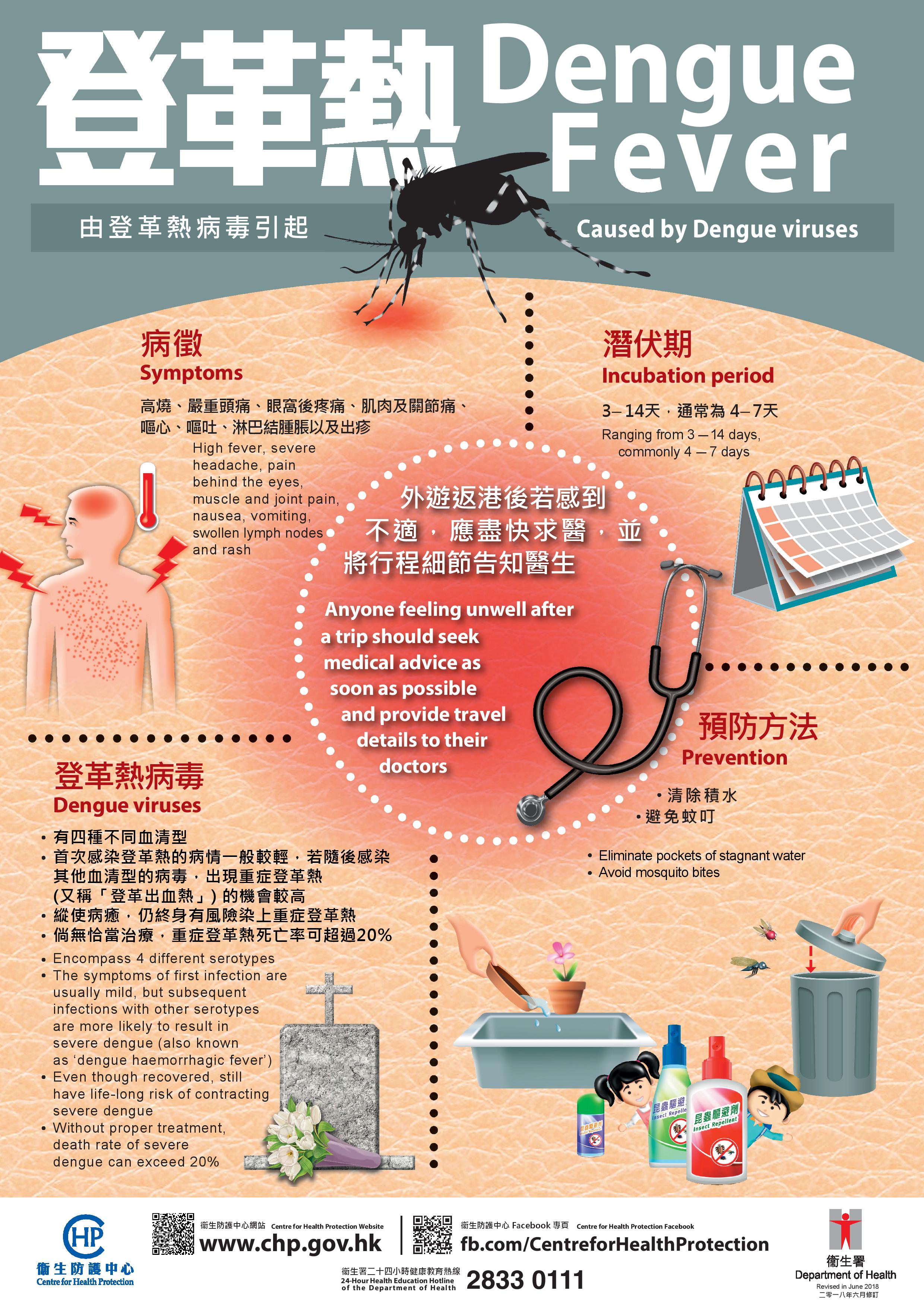
Prevention
Clothing, mosquito repellent, and netting can help reduce the risk for mosquito bites that can spread dengue fever and other infections. Limit outdoor activity during mosquito season, especially when they are most active, at dawn and dusk.
Centers for Disease Control and Prevention website. Dengue. www.cdc.gov/dengue/index.html. Updated August 3, 2022. Accessed December 8, 2022.
Endy TP. Viral febrile illnesses and emerging pathogens. In: Ryan ET, Hill DR, Solomon T, Aronson NE, Endy TP, eds.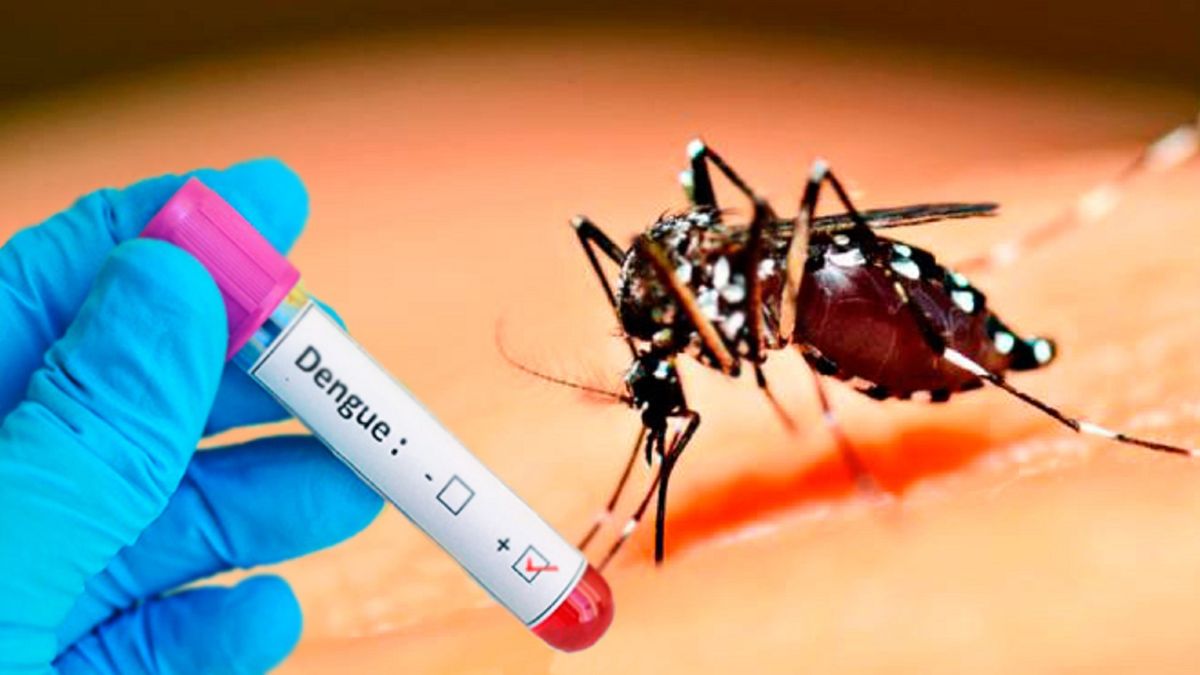 Hunter’s Tropical Medicine and Infectious Disease. 10th ed. Philadelphia, PA: Elsevier; 2020:chap 36.
Hunter’s Tropical Medicine and Infectious Disease. 10th ed. Philadelphia, PA: Elsevier; 2020:chap 36.
Thomas SJ, Endy TP, Rothman AL, Barrett AD. Flaviviruses (dengue, yellow fever, Japanese encephalitis, West Nile encephalitis, Usutu encephalitis, St. Louis encephalitis, tick-borne encephalitis, Kyasanur forest disease, Alkhurma hemorrhagic fever, Zika). In: Bennett JE, Dolin R, Blaser MJ, eds. Mandell, Douglas, and Bennett’s Principles and Practice of Infectious Diseases. 9th ed. Philadelphia, PA: Elsevier; 2020:chap 153.
World Health Organization website. Dengue and severe dengue. www.who.int/news-room/fact-sheets/detail/dengue-and-severe-dengue. Updated January 10, 2022. Accessed December 8, 2022.
Last reviewed on: 12/4/2022
Reviewed by: Jatin M. Vyas, MD, PhD, Associate Professor in Medicine, Harvard Medical School; Associate in Medicine, Division of Infectious Disease, Department of Medicine, Massachusetts General Hospital, Boston, MA. Also reviewed by David C. Dugdale, MD, Medical Director, Brenda Conaway, Editorial Director, and the A.D.A.M. Editorial team.
Dugdale, MD, Medical Director, Brenda Conaway, Editorial Director, and the A.D.A.M. Editorial team.
Dengue Fever – StatPearls – NCBI Bookshelf
Continuing Education Activity
Dengue is a mosquito-transmitted virus and the leading cause of arthropod-borne viral disease in the world. It is also known as breakbone fever due to the severity of muscle spasms and joint pain, dandy fever, or seven-day fever because of the usual duration of symptoms. Although most cases are asymptomatic, severe illness and death may occur. Aedes mosquitoes transmit the virus and are common in tropical and subtropical parts of the world. The incidence of dengue has increased dramatically over the past few decades, and the infection is now endemic in some parts of the world. A few people who were previously infected with one subspecies of the dengue virus develop severe capillary permeability and bleeding after being infected with another subspecies of the virus. This illness is known as dengue hemorrhagic fever. This activity reviews the etiology, presentation, evaluation, and management of dengue fever and examines the role of the interprofessional team in evaluating, diagnosing, and managing the condition.
This activity reviews the etiology, presentation, evaluation, and management of dengue fever and examines the role of the interprofessional team in evaluating, diagnosing, and managing the condition.
Objectives:
Describe the pathophysiology of dengue fever.
Review the symptomatic presentation of dengue fever along with physical exam findings.
Discuss the available management options for dengue fever, including prevention strategies.
Explain the importance of interprofessional team strategies for improving care coordination and communication to aid in prompt diagnosis of dengue fever and improve outcomes in patients diagnosed with the condition.
Access free multiple choice questions on this topic.
Introduction
Dengue is a mosquito-transmitted virus and the leading cause of arthropod-borne viral disease in the world. It is also known as breakbone fever due to the severity of muscle spasms and joint pain, dandy fever, or seven-day fever because of the usual duration of symptoms.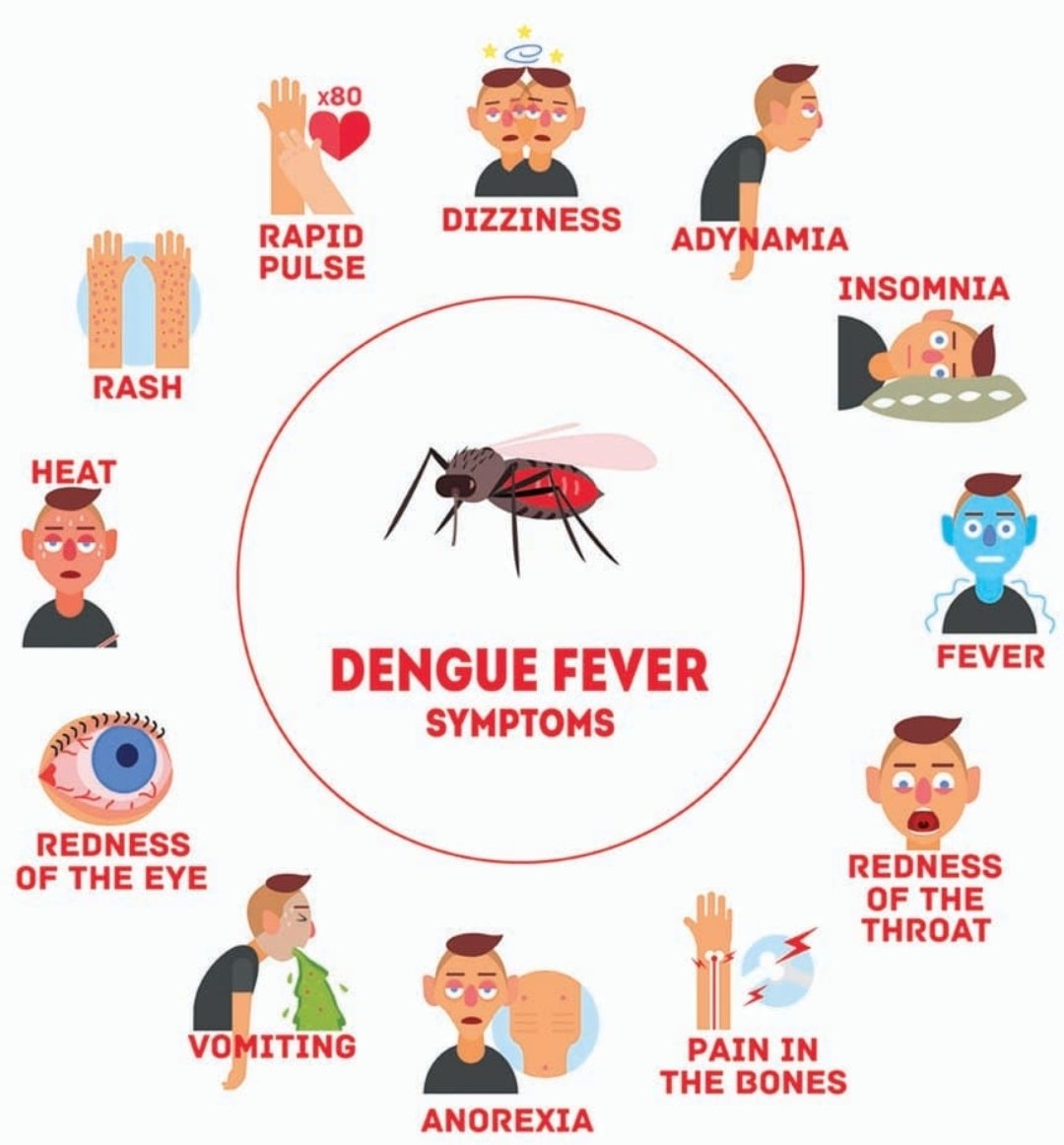 Although most cases are asymptomatic, severe illness and death may occur. Aedes mosquitoes transmit the virus and are common in tropical and subtropical parts of the world. The incidence of dengue has increased dramatically over the past few decades. The infection is now endemic in some parts of the world. A few people who were previously infected with one subspecies of the dengue virus develop severe capillary permeability and bleeding after being infected with another subspecies of the virus. This illness is known as dengue hemorrhagic fever.[1][2][3]
Although most cases are asymptomatic, severe illness and death may occur. Aedes mosquitoes transmit the virus and are common in tropical and subtropical parts of the world. The incidence of dengue has increased dramatically over the past few decades. The infection is now endemic in some parts of the world. A few people who were previously infected with one subspecies of the dengue virus develop severe capillary permeability and bleeding after being infected with another subspecies of the virus. This illness is known as dengue hemorrhagic fever.[1][2][3]
Etiology
Dengue fever is caused by any of four distinct serotypes (DENV 1-4) of single-stranded RNA viruses of the genus Flavivirus. Infection by one serotype results in lifelong immunity to that serotype but not to others.[4][5][6]
Epidemiology
It is the fastest spreading mosquito-borne viral disease globally, affecting greater than 100 million humans annually. Dengue also causes 20 to 25,000 deaths, primarily in children, and is found in more than 100 countries.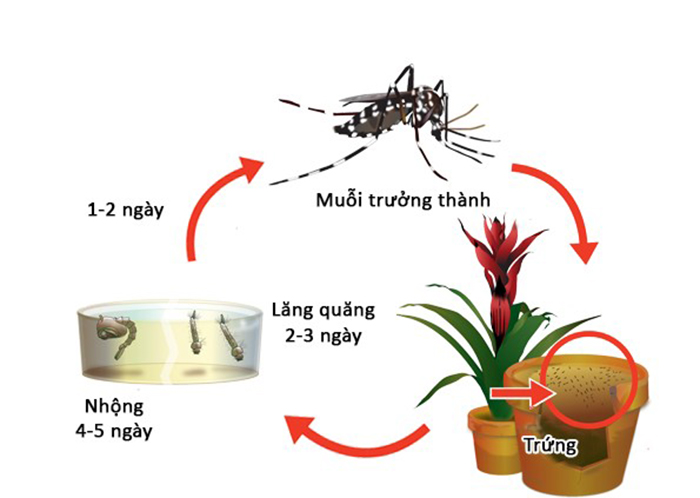 Epidemics occur annually in the Americas, Asia, Africa, and Australia. Two transmission cycles maintain the dengue virus: 1) mosquitos carry the virus from a non-human primate to a non-human primate, and 2) mosquitos carry the virus from human to human. The human-mosquito cycle occurs primarily in urban environments. Whether the virus transmits from human to mosquito depends on the viral load of the mosquito’s blood meal.
Epidemics occur annually in the Americas, Asia, Africa, and Australia. Two transmission cycles maintain the dengue virus: 1) mosquitos carry the virus from a non-human primate to a non-human primate, and 2) mosquitos carry the virus from human to human. The human-mosquito cycle occurs primarily in urban environments. Whether the virus transmits from human to mosquito depends on the viral load of the mosquito’s blood meal.
The primary vectors of the disease are female mosquitoes of the species Aedes aegypti and Aedes albopictus. Although A. aegypti is associated with most infections, A. albopictus’ range is expanding, tolerates cold environment better, is an aggressive feeder but feeds less frequently, and may be associated with increasing numbers. These species of mosquitoes tend to live indoors and are active during the day. Transmission by perinatally, blood transfusions, breast milk, and organ transplantation have been reported.
After 2010, the mean age of patients was 34 years compared to 27. 2 years from 1990 to 2010. The dengue viral serotype causing disease outbreaks have varied with time, as has the occurrence of severe dengue fever.[7][8]
2 years from 1990 to 2010. The dengue viral serotype causing disease outbreaks have varied with time, as has the occurrence of severe dengue fever.[7][8]
Transmission of dengue generally follows two patterns – epidemic dengue and hyperendemic dengue. When a single strain of DENV is responsible for introduction and transmission it is referred to as epidemic dengue. Dengue epidemics were more common prior to World War II. During an epidemic, all age groups are affected, but the incidence of dengue hemorrhagic fever is relatively low. Hyperendemicity refers to the co-circulation of various serotypes of DENV in a community. Periodic epidemics in an area are linked to the emergence of hyperendemicity.[9] Children are affected more than adults, and the incidence of DHF is relatively higher.
Pathophysiology
Part of the Flavivirus family, the dengue virus is a 50 nm virion with three structural and seven nonstructural proteins, a lipid envelope, and a 10.7 kb capped positive-sense single strand of ribonucleic acid.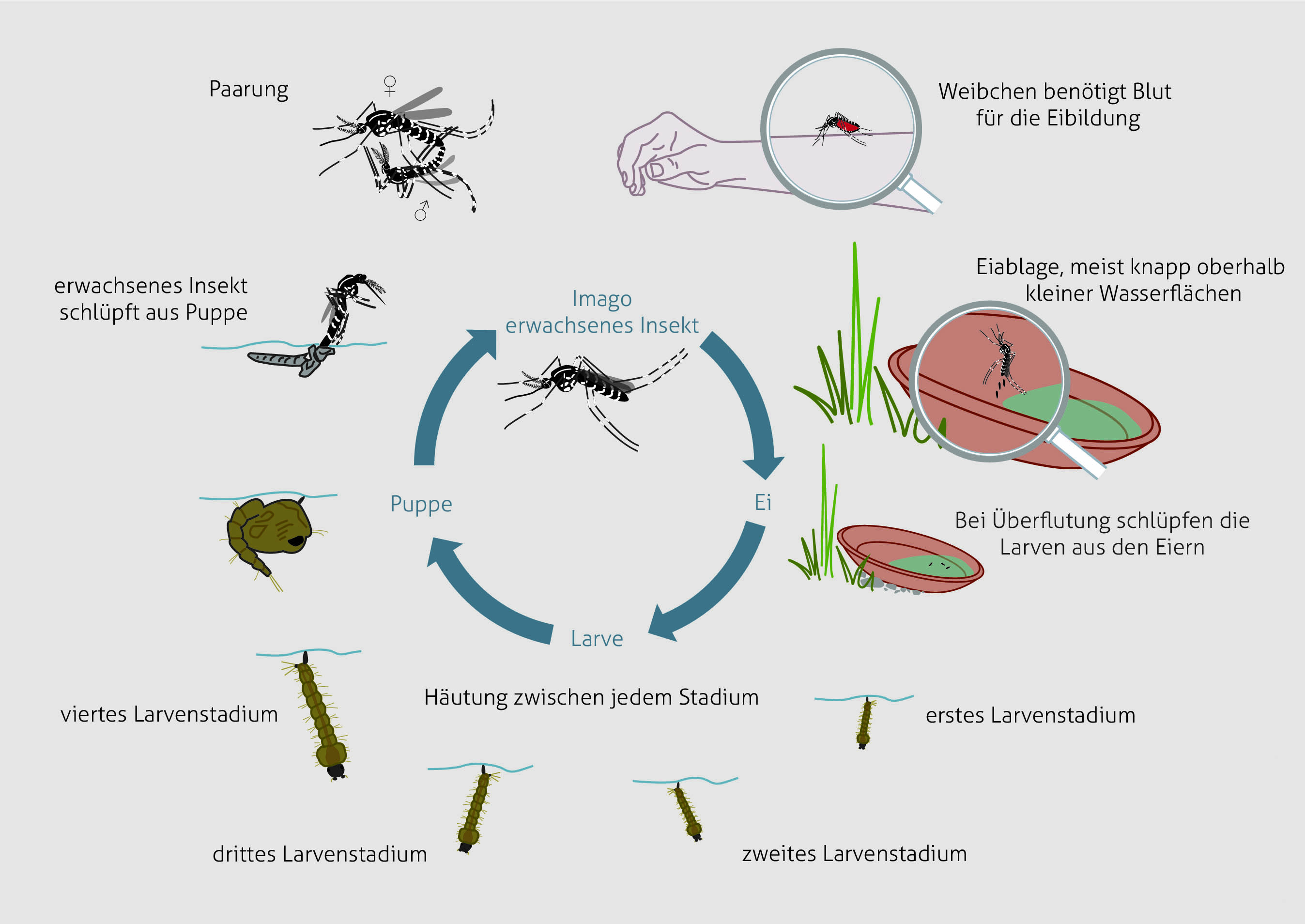 Infections are asymptomatic in up to 75% of infected humans. A spectrum of diseases, from self-limiting dengue fever to hemorrhage and shock, may be seen. A fraction of infections (0.5% to 5%) progress to severe dengue. Without proper treatment, fatality rates may exceed 20%. These occur primarily in children. The typical incubation period for the disease is 4 to 7 days, but it can last from 3 to 10 days. Symptoms more than two weeks after exposure are unlikely to be due to dengue fever.
Infections are asymptomatic in up to 75% of infected humans. A spectrum of diseases, from self-limiting dengue fever to hemorrhage and shock, may be seen. A fraction of infections (0.5% to 5%) progress to severe dengue. Without proper treatment, fatality rates may exceed 20%. These occur primarily in children. The typical incubation period for the disease is 4 to 7 days, but it can last from 3 to 10 days. Symptoms more than two weeks after exposure are unlikely to be due to dengue fever.
The exact course of events following the dermal injection of the dengue virus by a mosquito bite is unclear. Skin macrophages and dendritic cells appear to be the first targets. It is thought that the infected cells then move to the lymph nodes and spread through the lymphatic system to other organs. Viremia may be present for 24 to 48 hours before the onset of symptoms. A complex interaction of host and viral factors then occurs and determines whether the infection will be asymptomatic, typical, or severe.:quality(75)/arc-anglerfish-arc2-prod-elcomercio.s3.amazonaws.com/public/5UCDOTGLJVBJXE54ZJ37VRQS74.jpg) Severe dengue fever with increased microvascular permeability and shock syndrome is thought to be associated with infection due to a second dengue virus serotype and the patient’s immune response. However, cases of severe dengue do occur in the setting of infection by only a single serotype. Worsening microvascular permeability often transpires even as viral titers fall.
Severe dengue fever with increased microvascular permeability and shock syndrome is thought to be associated with infection due to a second dengue virus serotype and the patient’s immune response. However, cases of severe dengue do occur in the setting of infection by only a single serotype. Worsening microvascular permeability often transpires even as viral titers fall.
History and Physical
The three phases of dengue include febrile, critical, and recovery.
During the febrile phase, a sudden high-grade fever of approximately 40 C occurs that usually lasts two to seven days. Saddleback or biphasic fever is seen in approximately 6% of cases, particularly in patients with DHF and severe dengue. It is described as a fever that remits at least for one day, and the next fever spike starts, which lasts at least for one more day.[10] Associated symptoms include facial flushing, skin erythema, myalgias, arthralgias, headache, sore throat, conjunctival injection, anorexia, nausea, and vomiting. For skin erythema, a general blanchable macular rash occurs in the first one to two days of fever and the last day of fever. Or, within 24 hours, a secondary maculopapular rash can develop.
For skin erythema, a general blanchable macular rash occurs in the first one to two days of fever and the last day of fever. Or, within 24 hours, a secondary maculopapular rash can develop.
Defervescence characterizes the critical phase with a temperature of approximately 37.5 C to 38 C or less on days three through seven. It is associated with increased capillary permeability. This phase usually lasts one to two days. The onset of the critical phase is heralded by a rapid decline in platelet count, rise in hematocrit (the patient may have leukopenia up to 24 hours before platelet count drops), and the presence of warning signs. It can progress to shock, organ dysfunction, disseminated intravascular coagulation, or hemorrhage.
The recovery phase entails the gradual reabsorption of extravascular fluid in two to three days. The patient will display bradycardia at this time.
Expanded dengue syndrome refers to unusual or atypical manifestations in patients with dengue with neurological, hepatic, renal, and other isolated organ involvement. It could be due to profound shock. Neurological manifestations include febrile seizures in young children, encephalitis, aseptic meningitis, and intracranial bleeding. Gastrointestinal involvement may be seen in the form of hepatitis, liver failure, pancreatitis, or acalculous cholecystitis. It may also manifest as myocarditis, pericarditis, ARDS, acute kidney injury, or hemolytic uremic syndrome.
It could be due to profound shock. Neurological manifestations include febrile seizures in young children, encephalitis, aseptic meningitis, and intracranial bleeding. Gastrointestinal involvement may be seen in the form of hepatitis, liver failure, pancreatitis, or acalculous cholecystitis. It may also manifest as myocarditis, pericarditis, ARDS, acute kidney injury, or hemolytic uremic syndrome.
Evaluation
Common laboratory findings include thrombocytopenia, leukopenia, elevated aspartate aminotransferase. The disease is classified as dengue or severe dengue.[11][12][13]
Criteria for Dengue Include
Probable dengue: The patient lives in or has traveled to a dengue-endemic area. Symptoms include fever and two of the following: nausea, vomiting, rash, myalgias, arthralgias, rash, positive tourniquet test, or leukopenia.
Warning Signs of Dengue: Abdominal pain, persistent vomiting, clinical fluid accumulation such as ascites or pleural effusion, mucosal bleeding, lethargy, liver enlargement greater than 2 cm, increase in hematocrit, and thrombocytopenia.

Severe Dengue: Dengue fever with severe plasma leakage, hemorrhage, organ dysfunction including transaminitis greater than 1000 international units per liter, impaired consciousness, myocardial dysfunction, and pulmonary dysfunction
Dengue shock syndrome clinical warnings: Symptoms include rapidly rising hematocrit, intense abdominal pain, persistent vomiting, and narrowed or absent blood pressure.
The virus antigen is detectable by ELISA, polymerase chain reaction, or virus isolation from body fluids. Serology will reveal a marked increase in immunoglobulins. A confirmed diagnosis is established by culture, antigen detection, polymerase chain reaction, or serologic testing.
It is vital to assess pregnant patients with dengue as the symptoms may be very similar to preeclampsia.
Treatment / Management
Treatment of dengue depends on the patient’s illness phase. Those presenting early without any warning signs can be treated on an outpatient basis with acetaminophen and adequate oral fluids.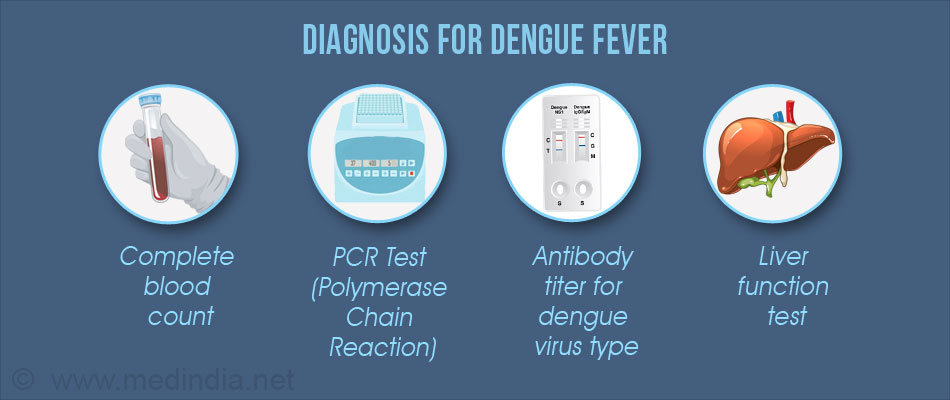 Such patients should receive an explanation regarding the danger signs and be asked to report to the hospital immediately if they notice any. Patients with warning signs, severe dengue, or other situations like infancy, elderly, pregnancy, diabetes, and those living alone need to be admitted. Those with warning signs can be initiated on IV crystalloids, and the fluid rate is titrated based on the patient’s response. Colloids can be started for patients in shock and are also preferred if the patient has already received previous boluses of crystalloid and has not responded. Blood transfusion is warranted in case of severe bleeding or suspected bleeding when the patient remains unstable, and hematocrit falls despite adequate fluid resuscitation. Platelet transfusion is considered when platelet count drops to <20,000 cells/microliter, and there is a high risk of bleeding. Avoid giving aspirin and nonsteroidal anti-inflammatory drugs, and other anticoagulants. No antiviral medications are recommended.
Such patients should receive an explanation regarding the danger signs and be asked to report to the hospital immediately if they notice any. Patients with warning signs, severe dengue, or other situations like infancy, elderly, pregnancy, diabetes, and those living alone need to be admitted. Those with warning signs can be initiated on IV crystalloids, and the fluid rate is titrated based on the patient’s response. Colloids can be started for patients in shock and are also preferred if the patient has already received previous boluses of crystalloid and has not responded. Blood transfusion is warranted in case of severe bleeding or suspected bleeding when the patient remains unstable, and hematocrit falls despite adequate fluid resuscitation. Platelet transfusion is considered when platelet count drops to <20,000 cells/microliter, and there is a high risk of bleeding. Avoid giving aspirin and nonsteroidal anti-inflammatory drugs, and other anticoagulants. No antiviral medications are recommended.
No laboratory tests can predict the progression to severe disease.
Differential Diagnosis
The clinical diagnosis of dengue can be challenging as many other illnesses can present similarly early in the disease course. Other considerations should include malaria, influenza, Zika, chikungunya, measles, and yellow fever. Obtain a detailed history of immunizations, travel, and exposures.
Rapid laboratory identification of dengue fever includes NS1 antigen detection and serologic tests. Serologic tests are only useful after several days of infection and may be associated with false positives due to other flavivirus infections, such as yellow fever or Zika virus.
Prognosis
Untreated severe dengue fever may have a mortality rate of 10% to 20%. Appropriate supportive care reduces the mortality rate to roughly 1%.
Complications
Liver injury
Cardiomyopathy
Pneumonia
Orchitis
Oophoritis
Seizures
Encephalopathy
Encephalitis
Postoperative and Rehabilitation Care
Patients should be encouraged to consume ample liquids. The return of a patient’s appetite is a sign that the infection is subsiding.
The return of a patient’s appetite is a sign that the infection is subsiding.
Consultations
Consulting an infectious disease specialist is recommended because most clinicians have little experience managing this infection. The Centers for Disease Control and Prevention has a hotline that also offers treatment advice.
Deterrence and Patient Education
The only way to avoid contracting dengue is to prevent mosquito bites and not travel to endemic areas.
Preventative measures include [14]-
Personal Prophylactic Measures: Use of bed nets while in bed even in the daytime, Insecticide-treated materials (ITMs) like window curtains, application of mosquito repellent creams (containing DEET, IR3535, or Icaridin), coils, developing the habit of wearing full sleeve shirts and pants help prevent mosquito bite.
Biological Control
a) Fish: Viviparous species Poecilia reticulata have been used in confined water bodies like large water tanks, open freshwater wells. Only native larvicidal fishes should be used.
Only native larvicidal fishes should be used.
b) Predatory Copepods: These small freshwater crustaceans have proven to be effective only in specific container habitats
c) Endosymbiotic control: Mosquitoes infected with Wolbachia (an intracellular parasite) are less susceptible to DENV infection than wild type A. aegypti.[15]
Chemical Control: Larvicidal use in big breeding containers; Insecticide spray: Space sprays can be applied as thermal fogs and cold aerosols. Oil-based formulations are preferred as it inhibits evaporation. Some of the commonly used insecticides are organophosphorus compounds (fenitrothion, malathion) and pyrethroids (bioresmethrin, cypermethrin).
Environmental Measures: Finding the breeding areas and eliminating the pests; proper management of rooftops and sunshades; appropriate covering of stored water like buckets, pots, etc
Health Education: It is the most important weapon to fight against dengue. Sensitizing the people regarding dengue in detail is necessary for the effective implementation of the dengue control program.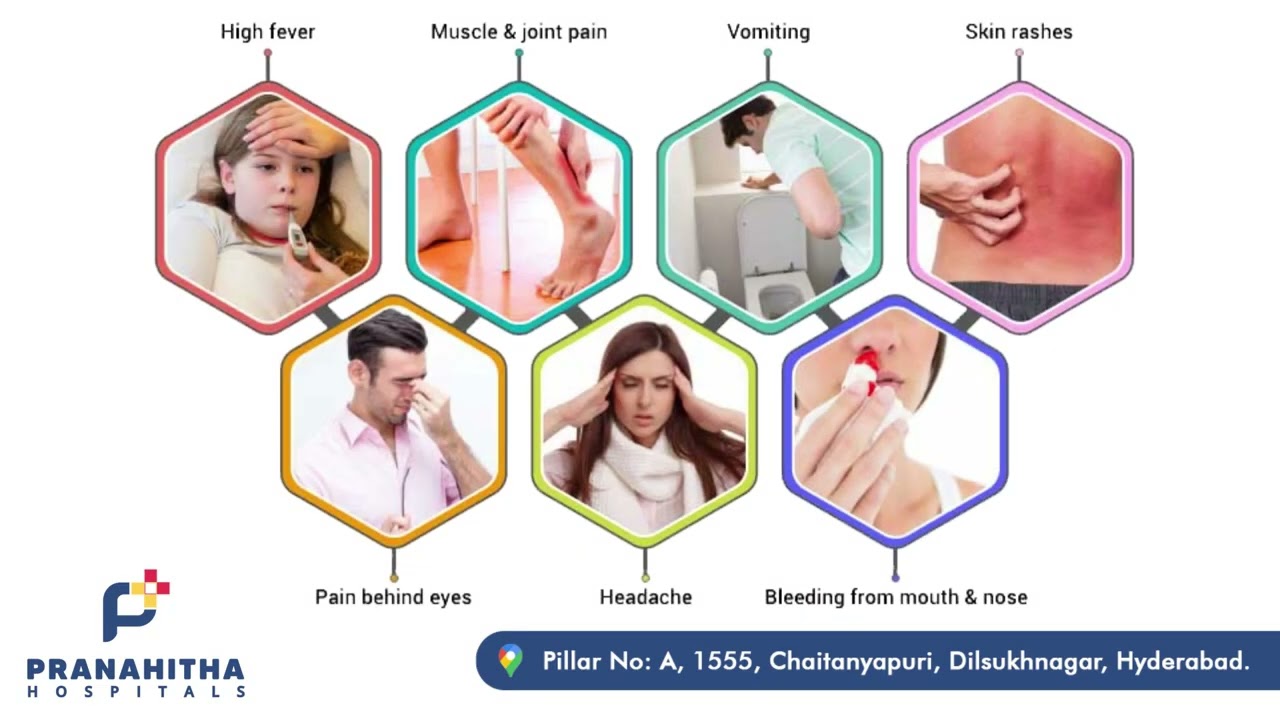 The sensitization can be done by audiovisual media or mass awareness campaigns.
The sensitization can be done by audiovisual media or mass awareness campaigns.
Community Participation: It’s essential to sensitize the communities for their active participation in dengue control programs.
Vaccination: CYD-TDV: a live recombinant tetravalent dengue vaccine, first to be licensed, is approved for endemic areas in 20 countries.[16]
Enhancing Healthcare Team Outcomes
The diagnosis and management of dengue are complex, and this is best managed by an interprofessional team that includes an infectious disease expert, a CDC consultant, an emergency department clinician, and an internist. The care is supportive with fluid, acetaminophen for fever, and a blood transfusion for hemorrhage. A confirmed diagnosis is established by culture, antigen detection, polymerase chain reaction, or serologic testing. No laboratory tests can predict the progression to severe disease.
The role of the primary care provider and nurse practitioner is to educate the traveler on the prevention of mosquito bites. This means covering exposed skin and using bed nets, particularly during daytime siestas, using mosquito repellents, and indoor insecticides. One should also eradicate mosquito breeding grounds like standing water. The prognosis for untreated dengue is abysmal, but most patients can survive with supportive care, albeit with residual multisystem organ damage.[17][18]
This means covering exposed skin and using bed nets, particularly during daytime siestas, using mosquito repellents, and indoor insecticides. One should also eradicate mosquito breeding grounds like standing water. The prognosis for untreated dengue is abysmal, but most patients can survive with supportive care, albeit with residual multisystem organ damage.[17][18]
Review Questions
Access free multiple choice questions on this topic.
Comment on this article.
Figure
Main symptoms of dengue fever. Contributed by Wikimedia Commons (Public Domain)
Figure
Mosquito carried diseases, Zika virus, Dengue fever, West Nile Fever, Chikungunya, Yellow Fever, Malaria. Contributed by National Institutes of Health (NIH)
References
- 1.
Baak-Baak CM, Cigarroa-Toledo N, Pech-May A, Cruz-Escalona GA, Cetina-Trejo RC, Tzuc-Dzul JC, Talavera-Aguilar LG, Flores-Ruiz S, Machain-Williams C, Torres-Chable OM, Blitvich BJ, Mendez-Galvan J, Garcia-Rejon JE.
 Entomological and virological surveillance for dengue virus in churches in Merida, Mexico. Rev Inst Med Trop Sao Paulo. 2019 Feb 14;61:e9. [PMC free article: PMC6376932] [PubMed: 30785563]
Entomological and virological surveillance for dengue virus in churches in Merida, Mexico. Rev Inst Med Trop Sao Paulo. 2019 Feb 14;61:e9. [PMC free article: PMC6376932] [PubMed: 30785563]- 2.
Sharma M, Glasner DR, Watkins H, Puerta-Guardo H, Kassa Y, Egan MA, Dean H, Harris E. Magnitude and Functionality of the NS1-Specific Antibody Response Elicited by a Live-Attenuated Tetravalent Dengue Vaccine Candidate. J Infect Dis. 2020 Mar 02;221(6):867-877. [PMC free article: PMC7325620] [PubMed: 30783676]
- 3.
Oliveira LNDS, Itria A, Lima EC. Cost of illness and program of dengue: A systematic review. PLoS One. 2019;14(2):e0211401. [PMC free article: PMC6382265] [PubMed: 30785894]
- 4.
Seixas G, Salgueiro P, Bronzato-Badial A, Gonçalves Y, Reyes-Lugo M, Gordicho V, Ribolla P, Viveiros B, Silva AC, Pinto J, Sousa CA. Origin and expansion of the mosquito Aedes aegypti in Madeira Island (Portugal). Sci Rep. 2019 Feb 19;9(1):2241. [PMC free article: PMC6381185] [PubMed: 30783149]
- 5.

Ghani NA, Shohaimi S, Hee AK, Chee HY, Emmanuel O, Alaba Ajibola LS. Comparison of Knowledge, Attitude, and Practice among Communities Living in Hotspot and Non-Hotspot Areas of Dengue in Selangor, Malaysia. Trop Med Infect Dis. 2019 Feb 15;4(1) [PMC free article: PMC6473475] [PubMed: 30781369]
- 6.
Maia LMS, Bezerra MCF, Costa MCS, Souza EM, Oliveira MEB, Ribeiro ALM, Miyazaki RD, Slhessarenko RD. Natural vertical infection by dengue virus serotype 4, Zika virus and Mayaro virus in Aedes (Stegomyia) aegypti and Aedes (Stegomyia) albopictus. Med Vet Entomol. 2019 Sep;33(3):437-442. [PubMed: 30776139]
- 7.
Prompetchara E, Ketloy C, Thomas SJ, Ruxrungtham K. Dengue vaccine: Global development update. Asian Pac J Allergy Immunol. 2020 Sep;38(3):178-185. [PubMed: 30660171]
- 8.
Vasanthapuram R, Shahul Hameed SK, Desai A, Mani RS, Reddy V, Velayudhan A, Yadav R, Jain A, Saikia L, Borthakur AK, Mohan DG, Bandyopadhyay B, Bhattacharya N, Dhariwal AC, Sen PK, Venkatesh S, Prasad J, Laserson K, Srikantiah P.
 Dengue virus is an under-recognised causative agent of acute encephalitis syndrome (AES): Results from a four year AES surveillance study of Japanese encephalitis in selected states of India. Int J Infect Dis. 2019 Jul;84S:S19-S24. [PubMed: 30641206]
Dengue virus is an under-recognised causative agent of acute encephalitis syndrome (AES): Results from a four year AES surveillance study of Japanese encephalitis in selected states of India. Int J Infect Dis. 2019 Jul;84S:S19-S24. [PubMed: 30641206]- 9.
Gubler DJ. The global emergence/resurgence of arboviral diseases as public health problems. Arch Med Res. 2002 Jul-Aug;33(4):330-42. [PubMed: 12234522]
- 10.
Ng DH, Wong JG, Thein TL, Leo YS, Lye DC. The Significance of Prolonged and Saddleback Fever in Hospitalised Adult Dengue. PLoS One. 2016;11(12):e0167025. [PMC free article: PMC5147856] [PubMed: 27936002]
- 11.
Nguyen-Tien T, Probandari A, Ahmad RA. Barriers to Engaging Communities in a Dengue Vector Control Program: An Implementation Research in an Urban Area in Hanoi City, Vietnam. Am J Trop Med Hyg. 2019 Apr;100(4):964-973. [PMC free article: PMC6447129] [PubMed: 30652660]
- 12.
Wharton-Smith A, Green J, Loh EC, Gorrie A, Omar SFS, Bacchus L, Lum LCS.
 Using clinical practice guidelines to manage dengue: a qualitative study in a Malaysian hospital. BMC Infect Dis. 2019 Jan 11;19(1):45. [PMC free article: PMC6329084] [PubMed: 30634929]
Using clinical practice guidelines to manage dengue: a qualitative study in a Malaysian hospital. BMC Infect Dis. 2019 Jan 11;19(1):45. [PMC free article: PMC6329084] [PubMed: 30634929]- 13.
Kellstein D, Fernandes L. Symptomatic treatment of dengue: should the NSAID contraindication be reconsidered? Postgrad Med. 2019 Mar;131(2):109-116. [PubMed: 30575425]
- 14.
Dengue: Guidelines for Diagnosis, Treatment, Prevention and Control: New Edition. World Health Organization; Geneva: 2009. [PubMed: 23762963]
- 15.
Flores HA, Taneja de Bruyne J, O’Donnell TB, Tuyet Nhu V, Thi Giang N, Thi Xuan Trang H, Thi Thuy Van H, Thi Long V, Thi Dui L, Le Anh Huy H, Thi Le Duyen H, Thi Van Thuy N, Thanh Phong N, Van Vinh Chau N, Thi Hue Kien D, Thuy Vi T, Wills B, O’Neill SL, Simmons CP, Carrington LB. Multiple Wolbachia strains provide comparative levels of protection against dengue virus infection in Aedes aegypti. PLoS Pathog. 2020 Apr;16(4):e1008433.
 [PMC free article: PMC7179939] [PubMed: 32282862]
[PMC free article: PMC7179939] [PubMed: 32282862]- 16.
Tricou V, Sáez-Llorens X, Yu D, Rivera L, Jimeno J, Villarreal AC, Dato E, Saldaña de Suman O, Montenegro N, DeAntonio R, Mazara S, Vargas M, Mendoza D, Rauscher M, Brose M, Lefevre I, Tuboi S, Borkowski A, Wallace D. Safety and immunogenicity of a tetravalent dengue vaccine in children aged 2-17 years: a randomised, placebo-controlled, phase 2 trial. Lancet. 2020 May 02;395(10234):1434-1443. [PubMed: 32197107]
- 17.
Nujum ZT, Saritha N, Prathibha Raj MR, Gayathri AV, Nirmala C, Vijayakumar K, Varghese S. Seroprevalence of dengue infection in pregnant women and placental antibody transfer. Med J Armed Forces India. 2019 Jan;75(1):90-95. [PMC free article: PMC6349639] [PubMed: 30705485]
- 18.
Gordon A, Gresh L, Ojeda S, Katzelnick LC, Sanchez N, Mercado JC, Chowell G, Lopez B, Elizondo D, Coloma J, Burger-Calderon R, Kuan G, Balmaseda A, Harris E. Prior dengue virus infection and risk of Zika: A pediatric cohort in Nicaragua.
 PLoS Med. 2019 Jan;16(1):e1002726. [PMC free article: PMC6342296] [PubMed: 30668565]
PLoS Med. 2019 Jan;16(1):e1002726. [PMC free article: PMC6342296] [PubMed: 30668565]
Disclosure: Timothy Schaefer declares no relevant financial relationships with ineligible companies.
Disclosure: Prasan Panda declares no relevant financial relationships with ineligible companies.
Disclosure: Robert Wolford declares no relevant financial relationships with ineligible companies.
Dengue fever consultation, examinations by an oncologist at ID-CLINIC St. Petersburg
Dengue fever consultation, examinations by an oncologist at ID-CLINIC St. Petersburg
Medical appointments
- Syphilidologist
- INFECTIONIST
- Dermatologist
- Therapist
- Cardiologist
- Oncologist
- Endocrinologist
- Neurologist
- Medical certificates
- Ultrasound diagnostics – Ultrasound
- Functional diagnostics
- Urologist
- Venereologist
- Parasitologist
- Mammologist
- All services
Diagnosis
- Gynecology
- Dermatovenereology
- Cardiology
- Neurology
- Oncology
- Therapy
- Urology
- Endocrinology
- Infectology
Treatment
- A
- B
- B
- D
- D
- E
- Yo
- F
- Z
- and
- Y
- K
- L
- M
- H
- O
- P
- P
- C
- T
- W
- F
- X
- C
- H
- W
- SC
- E
- Yu
- I
COVID
Full range of medical care for COVID virus infection
CHECK-UP
Full range of complex medical diagnostics
Tests
take tests at affordable prices
Drugs 9013 1
specialized pharmacy
Online
specialist consultation
DISCOUNTS
Only great deals for you!
St. Petersburg, Ivana Chernykh st., 25A
Petersburg, Ivana Chernykh st., 25A
Mon.-Sat. from 9:00 – 20:00, Sun. from 10:00 – 18:00
- home
- •
- Treatment
- •
- L
- •
Dengue fever
EXPERT ASSISTANCE
- herpes viruses
- human papillomavirus
- viral hepatitis
- mycobacteriosis
- HIV infection
- intrauterine, parasitic and other infectious diseases
Dengue fever, a mosquito fever infection that causes high fever and intoxication syndrome, can cause profuse bleeding. It is caused by pathogens from the flavivirus group (DENV-1, DENV-2, DENV-3 and DENV-4), which are transmitted to humans by the bite of mosquitoes.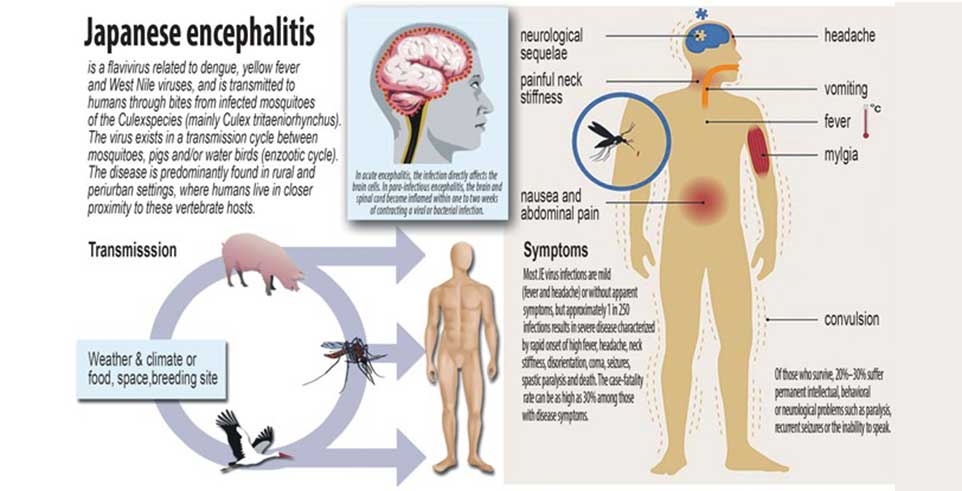 The disease is common in tropical latitudes, mainly in Southeast Asia and South America, and among Russians there are only imported cases from travelers.
The disease is common in tropical latitudes, mainly in Southeast Asia and South America, and among Russians there are only imported cases from travelers.
The first symptoms of Dengue
Clinical manifestations occur on average one week after infection. A person’s temperature rises sharply to 39-40 ° C, and the fever passes in 2 periods, each of which lasts 2-3 days and is replaced by the same sudden decrease in temperature to normal. Other signs of illness:
● severe “twisting” pains in the bones and joints
● headaches
● lack of appetite
● weakness
● redness of the skin of the face
● swollen lymph nodes
Complicated variant of the disease
After 3-7 days of illness, a critical stage may occur, which is characterized by a sharp deterioration in symptoms. The patient has severe abdominal pain, repeated vomiting, dehydration, impaired consciousness. Point hemorrhages appear on the skin.
Local residents often develop a hemorrhagic form of Dengue fever, which is manifested by bleeding from the gums, stomach and intestines. This variant of the disease is fraught with death.
This variant of the disease is fraught with death.
Medical advice
If a traveler develops a fever or other signs of infection during a trip or upon return, they need emergency medical attention. While abroad, you can get an ID-Clinic infectious disease consultation online via video link. For patients who are in the city, a doctor’s appointment with a home visit and an online consultation are available. It is undesirable to come to the clinic before finding out the cause of the fever, so as not to put other people at risk of infection.
Make an appointment
St. Petersburg, Ivan Chernykh st., 25A
Mon-Sat 09.00-20.00, Sun 10.00-18.00
By clicking on the “Sign up” button you agree to the processing of personal data
Online consultation
Convenient way,
at your convenience
By clicking on the “Sign up” button, you agree to the processing of personal data
Diagnosis of dengue fever
● detailed medical history and recent travel history
● physical examination
● serological reactions to virus antigens
● PCR diagnostics to confirm infection
● standard laboratory complex: clinical and biochemical blood tests, coagulogram
Disease prevention
No specific therapy has been developed against the causative agent of the disease, therefore treatment is limited to symptomatic drugs. At the height of the disease, antipyretics, infusion therapy, desensitizing and antihistamines are used. With the threat of bleeding, hemostatic therapy is carried out, in severe cases, patients require transfusion of blood components.
At the height of the disease, antipyretics, infusion therapy, desensitizing and antihistamines are used. With the threat of bleeding, hemostatic therapy is carried out, in severe cases, patients require transfusion of blood components.
Make an appointment
To get a consultation with an ID-Clinic infectious disease specialist in a convenient format and at a time that suits you, leave a request in the online form on this page. Our administrator will contact you and clarify the details of the registration.
Cost of clinic services
Inspection
Get service
| B01.014.001.001 | Primary appointment (examination, consultation) with an infectious disease specialist | 3000 ₽ |
| B01.014.001.003 | Repeated appointment (examination, consultation) with an infectious disease specialist | 3000 ₽ |
B01. 014.005.001 014.005.001 | Appointment (examination, consultation) with an infectious disease specialist at home | 6000 ₽ |
Online consultation of an infectious disease specialist | 3000 ₽ |
Other clinic services
Online consultation with an infectious disease specialist
INFECTIONIST
SavchenkoMikhail Andreevich
Infectionist,
Hepatologist,
Doctor of the first category,
Candidate of Medical SciencesMake an appointment
EfimovGeorgy Alexandrovich
Infectionist,
ParasitologistMake an appointment
Tatyana Sergeevna Korneeva
Infectionist,
Hepatologist,
Sonographer,
PhDMake an appointment
Sizova Natalia Vladimirovna
Infectionist,
Doctor of the highest category,
Doctor of Medical Sciences,
ProfessorMake an appointment
MayorovaSvetlana Olegovna
Infectionist,
Doctor of the highest category,
Candidate of Medical SciencesMake an appointment
Zvontsova Svetlana Alexandrovna
Infectionist,
ParasitologistMake an appointment
Lavrenchuk Dmitry Vadimovich
Infectionist,
Hepatologist,
Therapist,
PhDMake an appointment
Fadeev Kirill Alexandrovich
Infectionist,
Hepatologist,
Parasitologist,
Doctor of the highest category,
Candidate of Medical SciencesMake an appointment
Kiseleva Lyudmila Ivanovna
Therapist,
Pulmonologist,
Ultrasound doctor,
SomnologistMake an appointment
Balandina Anna Borisovna
Infectionist,
Hepatologist,
Parasitologist,
RabiologistMake an appointment
Selivanova Marina Andreevna
Infectionist,
Hepatologist,
Parasitologist,
RabiologistMake an appointment
KononchukOlga Nikolaevna
Infectionist,
Hepatologist,
Therapist,
Phthisiatrician,
Functional Diagnostics Doctor,
Doctor of the highest category,
Candidate of Medical SciencesMake an appointment
Kuznetsov Alexey Romanovich
Infectionist,
HepatologistMake an appointment
All specialists
Read reviews
Promotions and special offers
Stories and reviews of our patients
Miroslavche Indzhova
We thank the staff for the good work, polite, fast and patient service! My husband needed covid tests. Done quickly and with translation! Special thanks to Sergey Alexandrovich Bortulev
Done quickly and with translation! Special thanks to Sergey Alexandrovich Bortulev
Specialist:
Bortulev Sergey Alexandrovich
Prodoctors
This is, perhaps, the best paid medical institution where I have ever been) I was in very expensive and famous ones, and H-Clinic is really top. I liked absolutely everything. The approach, including to problematic conflict clients like me, the staff is perfect, everything is here just for you, and there are no forced false smiles and other things. People are really helpful and kind. Bazyuk, an infectious disease specialist, is a doctor by vocation. Even the nurse (dark with a tattoo) did the vaccination with great dedication (I feel such things). I am very grateful to you all. The clinic is clean, the service is 5+, there is a charge, you can ask for a second coffee with double cream, there are even condoms in a vase (I took it as a gift for schoolchildren)
Prodoctorov
I have been seeing Daria Mikhailovna for the third year. A very kind and caring doctor who is very professional in his field.
A very kind and caring doctor who is very professional in his field.
Specialist:
Surzhenko Daria Mikhailovna
Anonymous
An excellent doctor competent treatment helped to restore the work of the heart and blood pressure in order to prepare for the operation and transfer it. Thanks Oleg Viktorovich.
User NaPopravka
Kirill Yurievich, an oncourologist, was very pleased. Friendly, attentive. He listened to me, suggested me, ordered tests. Everything was to the point, nothing superfluous was offered, but only what was needed.
Specialist:
Krotov Kirill Yurievich
Prodoctorov
Visited an endocrinologist Darya Mikhailovna Surzhenko. Very caring, intelligent, and caring doctor! There were problems related to the activity of thyroid hormones. Quite a bit of time has passed, and the indicators, well-being and mood have already improved. I will definitely recommend to my friends, because I know for myself how difficult it is to find a good specialist in this field. Thanks to the administration of “H-Clinic” for the professionalism and selection of doctors with such tremendous experience! Excellent clinic.
Thanks to the administration of “H-Clinic” for the professionalism and selection of doctors with such tremendous experience! Excellent clinic.
Specialist:
Surzhenko Daria Mikhailovna
User (SberZdorovye)
The reception went very well. The doctor listened to me carefully, immediately understood the essence of my problem, explained everything in detail, answered all my questions. I really liked the doctor, sensitive, delicate, very pleasant. I would recommend this specialist.
Specialist:
Balandina Anna Borisovna
Correction User
At ID-Clinic, we have made appointments with Mikhail Andreevich Savchenko more than once. Mikhail Andreevich is a very good doctor, attentive, patient. As a result, we received help, the prescribed treatment helped. We rate the professionalism of the specialist at 5. The clinic also arranged it: clean, friendly staff.
Specialist:
Savchenko Mikhail Andreevich
Prodoctorov
Evgenia Mikhailovna, a doctor really by vocation. I visited her in the clinic for Ivan Chernykh, it is clear that the doctor really gives all the best, devotes himself to his work. Thoroughly examined, picked up the treatment, gave recommendations. Very pleasant in communication, natural in the desire to help without flattery, sycophancy and antics. All clinic staff are excellent.
I visited her in the clinic for Ivan Chernykh, it is clear that the doctor really gives all the best, devotes himself to his work. Thoroughly examined, picked up the treatment, gave recommendations. Very pleasant in communication, natural in the desire to help without flattery, sycophancy and antics. All clinic staff are excellent.
Didn’t like it
There is no such thing and I’m sure it won’t happen.
Comment
It’s rather strange, but I caught myself thinking that someday I wanted to be treated in this clinic, everything is so sincere there. Now, in gratitude to the doctor and the institution, I draw 2 pictures for the hall).
Specialist:
Bazyuk Evgenia Mikhailovna
On June 5, we had an appointment with Kirill Aleksandrovich at the IIdClinic. They came scared, in a depressed mood. From the first minute, the doctor won over with his attitude, professionalism and a very tactful and attentive approach to the patient. He explained everything in an accessible way, explained every little thing, what tests needed to be taken, dispelled all our fears and doubts! Kirill Alexandrovich is a professional with a capital letter, and a specialist who treats his patients with great warmth.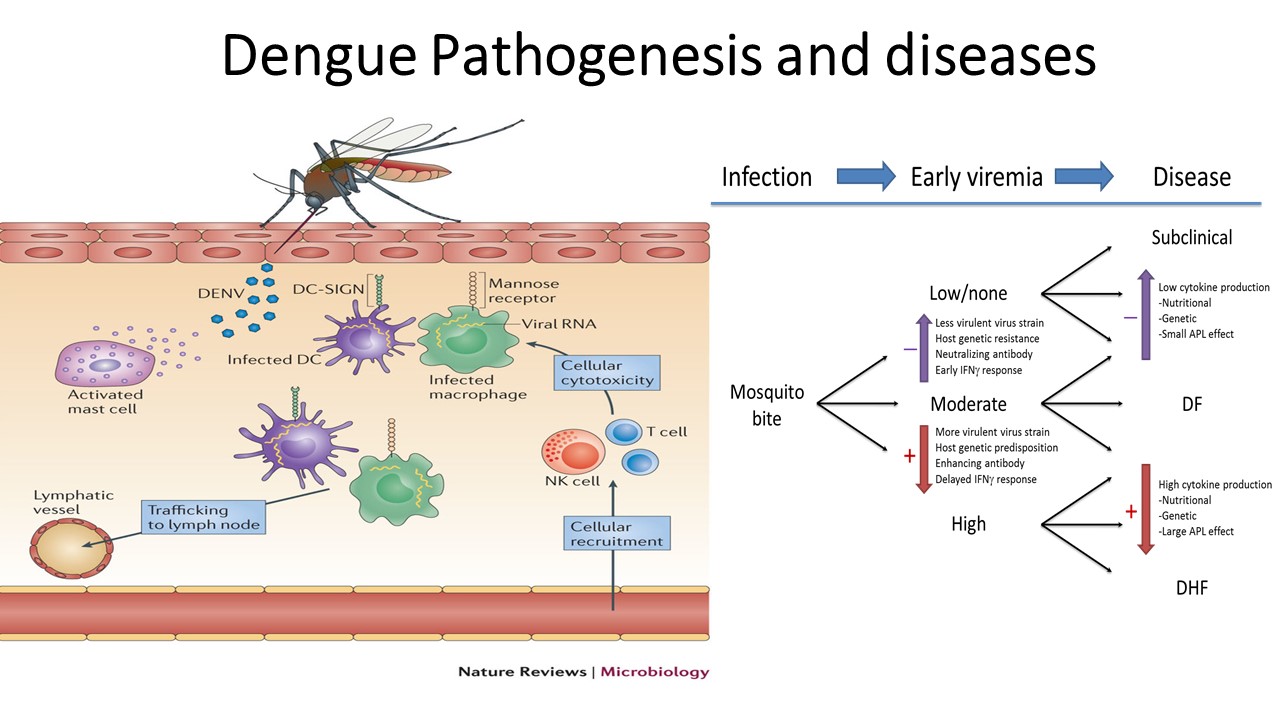 We are very grateful to him for the recommendations and the prescribed treatment.
We are very grateful to him for the recommendations and the prescribed treatment.
Specialist:
Krotov Kirill Yurievich
Show more reviews of
Contraindicated,
Specialist consultation required
Dengue and severe dengue
Key facts
Dengue is a viral infection transmitted by humans through the bites of infected mosquitoes. The main carriers of the disease are mosquitoes Aedes aegypti, less often Ae. albopictus.
The causative agent of infection is dengue virus (DENV). There are four serotypes of DENV, making it possible to get dengue four times.
Although many DENV infections are mild, the virus can cause an acute flu-like illness. Sometimes a potentially fatal complication called severe dengue can develop.
There is no specific treatment for dengue/severe dengue. Early detection of the progression of severe dengue and provision of appropriate medical care can reduce the death rate from the disease to below 1%.
Dengue is found in tropical and subtropical regions throughout the world, mainly in urban and suburban areas.
The global incidence of dengue is on the rise and about half of the world’s population is now at risk of the disease. Although the number of infections is estimated at 100-400 million annually, more than 80% of cases are usually mild or asymptomatic.
Successful prevention and treatment of dengue depends on the effectiveness of vector control measures. Regular community participation can improve the quality of vector control measures.
General information
Dengue is a mosquito-borne viral disease that has spread rapidly in all WHO regions in recent years. Dengue virus vectors are female mosquitoes, mainly Aedes aegypti and, to a lesser extent, Ae. albopictus. These mosquitoes are also carriers of chikungunya, yellow fever and Zika viruses. Dengue is widespread in the tropics, with the risk of infection varying from place to place depending on climate, social and environmental factors.
Dengue causes a wide range of clinical manifestations. In infected people, they can range from subclinical manifestations (people may not be aware of infection) to severe flu-like symptoms. Some patients, although less frequently, develop severe dengue, which can manifest as a series of complications due to severe bleeding, organ damage, and/or plasma leakage from the bloodstream. If left untreated, severe dengue is more likely to be fatal. Severe dengue was first identified at 1950s during dengue epidemics in the Philippines and Thailand. Severe dengue is now common in most Asian and Latin American countries and is one of the leading causes of hospitalization and death among children in these regions.
Dengue is caused by a virus of the Flaviviridae family; There are four distinct but closely related virus serotypes that cause dengue (DENV-1, DENV-2, DENV-3 and DENV-4). It is assumed that after an infection, a person develops lifelong immunity to a specific serotype. However, cross-immunity to other serotypes after recovery is only partial and temporary. Subsequent episodes of infection (secondary infection) with other serotypes increase the risk of developing severe dengue.
Subsequent episodes of infection (secondary infection) with other serotypes increase the risk of developing severe dengue.
Dengue has distinct epidemiological patterns associated with the four serotypes of the virus. Different serotypes can circulate simultaneously within the same region, and in fact many countries are hyperendemic for all four serotypes. The implications of dengue for children’s health and for the global and national economy are alarming. DENV is often carried from one place to another by infected individuals during travel; the presence of potential carriers in the areas of arrival of such persons creates the prerequisites for local transmission of the infection.
Global burden of disease
The incidence of dengue has increased dramatically worldwide in recent decades. In the vast majority of those infected, the infection is asymptomatic or mild and without seeking medical help, and therefore actual cases of the disease are not fully recorded.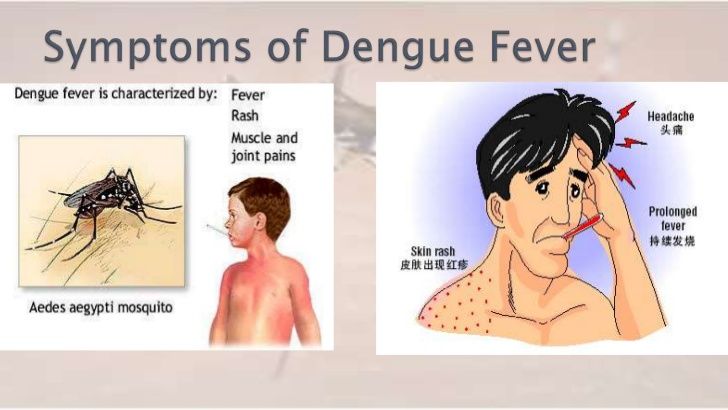 In addition, dengue is often mistaken for other febrile illnesses [1].
In addition, dengue is often mistaken for other febrile illnesses [1].
According to one model, 390 million dengue virus infections occur each year (95% confidence interval is 284-528 million), of which 96 million (67-136 million) are clinically manifested (with any severity of the disease) [2]. Another dengue prevalence study estimated that 3.9 million people are at risk of contracting dengue viruses. Although 129 countries are at risk of infection [3], 70% of the actual disease burden is in Asia [2].
Over the past two decades, the number of dengue cases reported to WHO has increased more than eight-fold, from 505,430 cases in 2000 to over 2.4 million in 2010 and 5.2 million in 2019d. The number of reported deaths increased from 960 to 4032 between 2000 and 2015; mortality is predominantly in younger age groups. In 2020–2021 the total number of cases, as well as reported deaths, appears to have declined. However, available data is still incomplete, and in some countries the COVID-19 pandemic may have prevented case registration.
The prevailing overall upward trend in incidence over the past two decades is partly due to changes in national methodologies for registering cases and reporting dengue to ministries of health and WHO. But it also shows that governments recognize the burden of dengue and therefore the importance of reporting on this burden.
Distribution and outbreaks
Prior to 1970, severe dengue epidemics occurred in only nine countries. The disease is now endemic in more than 100 countries in the regions of Africa, the Americas, the Eastern Mediterranean, Southeast Asia and the Western Pacific. The regions of the Americas, South-East Asia and the Western Pacific are most affected, with Asia accounting for about 70% of the global disease burden.
The spread of the disease to new areas, including in Europe, is accompanied not only by an increase in the number of cases, but also by rapid outbreaks. The threat of dengue outbreaks in Europe has emerged in recent years; in 2010, local transmission was reported for the first time in France and Croatia, and imported cases were detected in three other European countries. In 2012, a dengue outbreak in Madeira, Portugal, infected more than 2,000 people, with imported cases in mainland Portugal and ten other countries in Europe. At present, autochthonous cases of the disease occur almost annually in some European countries.
In 2012, a dengue outbreak in Madeira, Portugal, infected more than 2,000 people, with imported cases in mainland Portugal and ten other countries in Europe. At present, autochthonous cases of the disease occur almost annually in some European countries.
The highest number of reported cases of dengue in the world occurred in 2019. The disease has affected all regions, with dengue transmission first detected in Afghanistan.
In the Region of the Americas alone, 3.1 million cases were reported, of which more than 25 000 were classified as severe. Despite alarming incidence rates, dengue-related mortality was lower than the previous year.
Significant numbers of dengue cases have been reported in Asian countries: Bangladesh (101 000), Malaysia (131 000), Philippines (420 000) and Viet Nam (320 000).
In 2020, dengue was introduced into several new countries, such as Bangladesh, Brazil, India, Indonesia, Yemen, Mauritania, Maldives, Mayotte (France), Nepal, Cook Islands, Singapore, Sudan, Thailand , Timor-Leste, Sri Lanka and Ecuador, there was an increase in the number of cases. In 2021, the spread of dengue continued in Brazil, India, Viet Nam, the Philippines, the Cook Islands, Colombia, Fiji, Kenya, Paraguay, Peru and Reunion Island.
In 2021, the spread of dengue continued in Brazil, India, Viet Nam, the Philippines, the Cook Islands, Colombia, Fiji, Kenya, Paraguay, Peru and Reunion Island.
COVID-19 pandemicputs an extremely heavy burden on health systems and governments around the world. WHO emphasizes the importance of continuing efforts to prevent, detect and treat vector-borne diseases such as dengue and other arbovirus infections during a pandemic, given the increase in the number of cases of both groups of diseases that most threaten urban populations. The combined impact of the COVID-19 and dengue epidemics could be catastrophic for at-risk populations.
Transmission
Transmission by mosquito bites
The virus is transmitted to humans when they are bitten by an infected female mosquito, mainly Aedes aegypti. Other species of the genus Aedes may also be carriers, but to a lesser extent than Aedes aegypti.
The virus enters the mosquito when the mosquito bites a DENV-infected human, then replicates in the mosquito’s midgut and then spreads to secondary tissues, including the salivary glands. The period of time from the moment a virus enters a mosquito until it is actually transmitted to a new host is called the external incubation period (EIP). At an ambient temperature in the range of 25–28°C, the WTI is about 8–12 days [4–6]. The duration of the external incubation period is affected not only by the ambient temperature; the time required for a mosquito to transmit the virus may also vary under the influence of a number of other factors, such as the range of diurnal temperature fluctuations [7, 8], the virus genotype [9] and the initial concentration of the virus [10]. Once infected, the mosquito is able to transmit the virus for the rest of its life.
The period of time from the moment a virus enters a mosquito until it is actually transmitted to a new host is called the external incubation period (EIP). At an ambient temperature in the range of 25–28°C, the WTI is about 8–12 days [4–6]. The duration of the external incubation period is affected not only by the ambient temperature; the time required for a mosquito to transmit the virus may also vary under the influence of a number of other factors, such as the range of diurnal temperature fluctuations [7, 8], the virus genotype [9] and the initial concentration of the virus [10]. Once infected, the mosquito is able to transmit the virus for the rest of its life.
Human-to-mosquito transmission
Mosquitoes can become infected from people infected with DENV. These may include individuals with symptomatic dengue infection, individuals who do not yet have a symptomatic infection (presymptomatic patients), and individuals who do not show any signs of the disease (asymptomatic patients) [11].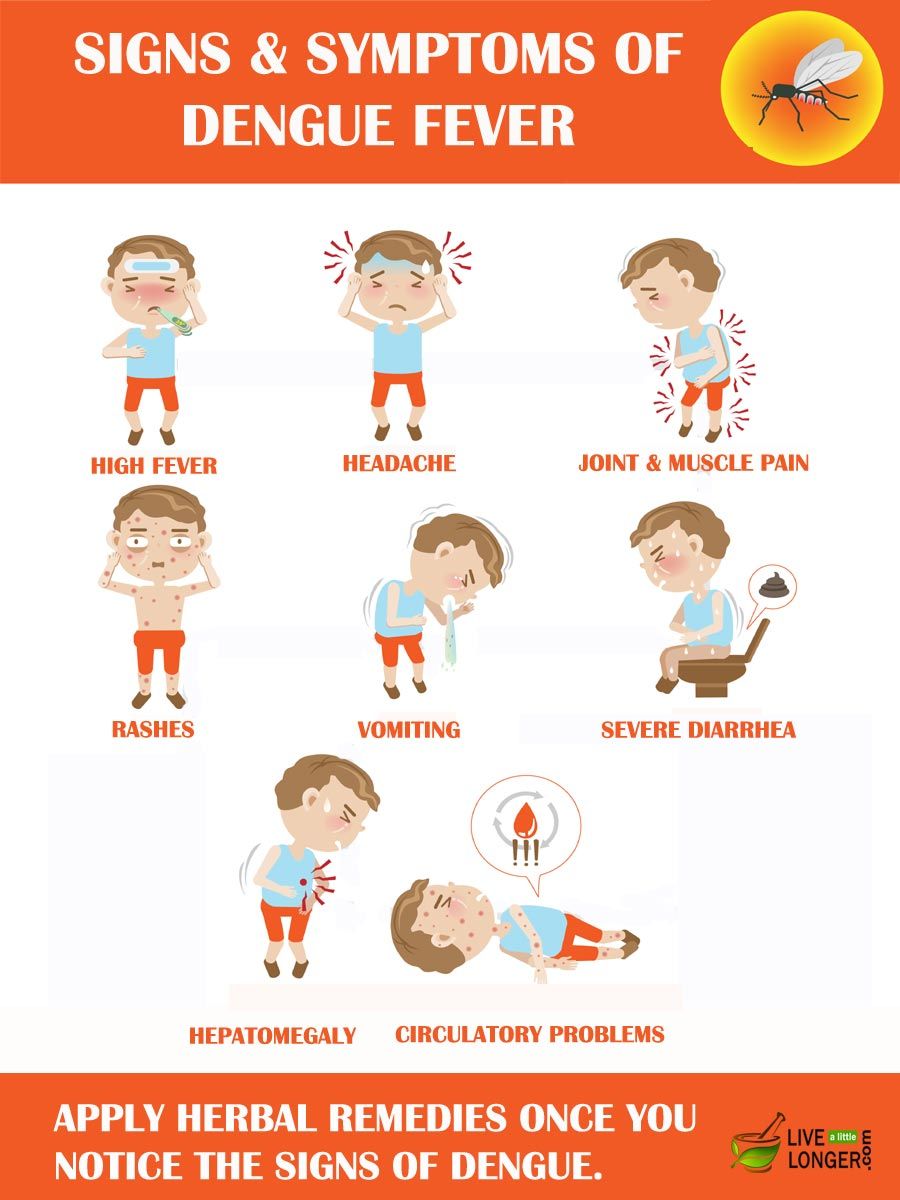
Human-to-mosquito transmission is possible from two days before the onset of human symptoms [5, 11] to two days after the end of fever [12].
The risk of mosquito infection is positively correlated with high levels of viremia and high temperature in the patient; conversely, high levels of DENV-specific antibodies are associated with a reduced risk of mosquito infection (Nguyen et al 2013 PNAS). Most people remain contagious for about four to five days, but viremia can last up to 12 days [13].
Mother-to-child transmission
Mosquitoes are the main human vectors of DENV. However, there is evidence of possible mother-to-child transmission (from a pregnant woman to her child). Vertical transmission rates appear to be low, but the risk appears to be related to how early in pregnancy dengue infection occurs [14–17]. Children of mothers infected with DENV during pregnancy may suffer from prematurity, low birth weight, and fetal distress [18].
Other modes of transmission
Rare cases of transmission of the virus through blood products, organ donation and blood transfusion have been reported. There have also been cases of transovarial transmission of the virus in mosquito populations.
There have also been cases of transovarial transmission of the virus in mosquito populations.
Environmental vectors
Aedes aegypti mosquitoes are considered to be the main vectors for DENV. They can breed in natural reservoirs such as tree holes and bromeliads, but have now become well adapted to the urban environment and breed mainly in artificial containers such as buckets, ceramic pots, orphan containers and worn car tires, storm sewer manholes. etc., resulting in widespread dengue risk in densely populated urban areas. a.e. aegypti feed during the daytime; the peak time of their bites is in the early morning and evening before sunset [19]. For each feeding period, the female Ae. Aegypti bites a large number of people, resulting in outbreaks of group morbidity [20]. Eggs laid by the female can remain viable in a dry environment for several months, and on contact with water, larvae hatch from them.
Aedes albopictus, the second most important vector of dengue, has spread to more than 32 states in the US and more than 25 countries in the European Region, largely as a result of international trade in used tires (which are a breeding ground) and other commodities (such as ornamental bamboo). It prefers to breed near dense vegetation, including crops, putting agricultural workers at increased risk of infection, particularly in rubber and oil palm plantations, but also forms large populations in urban areas. a.e. Albopictus easily adapts to new conditions. Its geographic distribution is largely determined by the ability to tolerate lower temperatures both at the egg stage and as an adult [21, 22]. Like A.E. aegypti, Ae. albopictus feeds during the day and is the main vector of DENV in a limited number of outbreaks, where Aedes aegypti is either absent or present in low numbers [23, 24].
It prefers to breed near dense vegetation, including crops, putting agricultural workers at increased risk of infection, particularly in rubber and oil palm plantations, but also forms large populations in urban areas. a.e. Albopictus easily adapts to new conditions. Its geographic distribution is largely determined by the ability to tolerate lower temperatures both at the egg stage and as an adult [21, 22]. Like A.E. aegypti, Ae. albopictus feeds during the day and is the main vector of DENV in a limited number of outbreaks, where Aedes aegypti is either absent or present in low numbers [23, 24].
Characteristics of the disease (signs and symptoms)
Although most cases of dengue are asymptomatic or have mild symptoms, it can present as a severe flu-like illness that affects infants, young children and adults, but is rarely fatal . Symptoms usually last 2–7 days after an incubation period of four to ten days following an infected mosquito bite [25]. The World Health Organization distinguishes between two main categories of disease: dengue (with/without signs of complications) and severe dengue.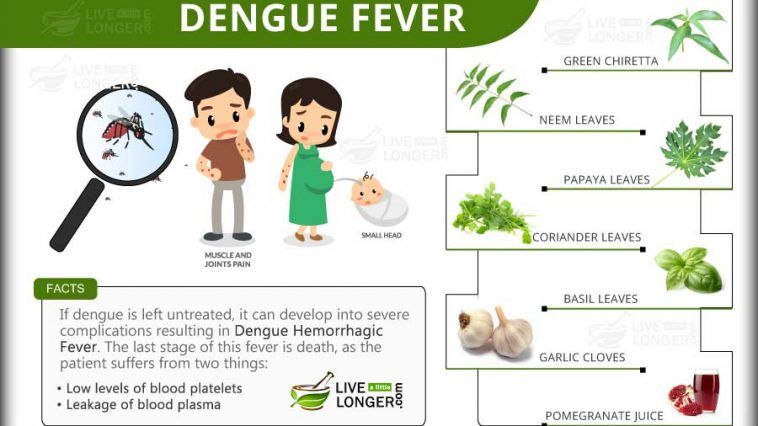 Classification into the subcategories “dengue with signs of complications” and “dengue without signs of complications” is intended to assist healthcare professionals in triaging hospitalized patients, ensuring close monitoring, and minimizing the risk of developing more severe dengue [25].
Classification into the subcategories “dengue with signs of complications” and “dengue without signs of complications” is intended to assist healthcare professionals in triaging hospitalized patients, ensuring close monitoring, and minimizing the risk of developing more severe dengue [25].
Dengue
Dengue should be suspected when a high temperature (40°C/104°F) in the febrile stage (2-7 days) is accompanied by two of the following symptoms:
severe headache;
eye pain;
muscle and joint pain;
nausea;
vomiting;
swollen glands;
rash.
Severe dengue
3-7 days after the onset of the disease, the patient usually enters the so-called critical stage. During the critical phase, lasting 24 to 48 hours, a small proportion of patients may experience a sudden worsening of symptoms. It is at this time when the temperature drops (below 38°C/100°F) that the patient may show signs of complications associated with severe dengue. Severe dengue is a complication that can be fatal due to leakage of plasma from the bloodstream, fluid accumulation, respiratory failure, severe bleeding, or organ damage.
Severe dengue is a complication that can be fatal due to leakage of plasma from the bloodstream, fluid accumulation, respiratory failure, severe bleeding, or organ damage.
Signs of complications that the doctor should look out for include the following:
severe abdominal pain;
persistent vomiting;
rapid breathing;
bleeding gums or epistaxis;
weakness;
excited state;
liver enlargement;
blood in vomit or stool.
Patients who develop the above symptoms in a critical stage should be closely monitored for the next 24-48 hours to allow them to receive appropriate medical care to avoid complications and the risk of death. It must continue into the recovery phase.
Diagnosis
Several methods can be used to diagnose DENV infection. The use of various diagnostic methods may be more or less appropriate, depending on the time of the patient’s presentation. Biomaterial samples from patients obtained during the first week of illness should be examined by both methods listed below.
Virus isolation methods
Virus can be isolated from the blood during the first few days of infection. There are various methods based on the reverse transcription polymerase chain reaction (RT-PCR), which is considered the “gold standard” of diagnostics. Such methods, however, require special equipment and technical training of the testing personnel.
The virus can also be detected by testing for a viral protein called NS1. To do this, commercially available rapid diagnostic tests are available that provide results in as little as about 20 minutes without any special laboratory techniques or equipment.
Serological tests
Serological tests, such as enzyme immunoassay (ELISA), can confirm the presence of a recent or past infection with the detection of antibodies to dengue. IgM antibodies are detected approximately one week after infection and can be detected for approximately three months. The presence of IgM is indicative of a recent DENV infection. IgG antibodies take longer to form and remain in the body for years. The presence of IgG is indicative of past infection.
IgG antibodies take longer to form and remain in the body for years. The presence of IgG is indicative of past infection.
Treatment
There is no specific treatment for dengue fever. In case of illness, it is necessary to observe rest and drinking regimen and seek medical help. Depending on the clinical manifestations and other circumstances, the patient may be allowed to go home, referred to a hospital for treatment, or deemed in need of emergency care or emergency transfer to another medical facility[25].
Supportive care, such as antipyretics and pain medications, may be given to relieve muscle and other pain and to reduce fever.
Acetaminophen or paracetamol is the best treatment for these symptoms.
NSAIDs (non-steroidal anti-inflammatory drugs) such as ibuprofen and aspirin should be avoided. These anti-inflammatory drugs work by thinning the blood, and in a disease with a risk of bleeding, anticoagulants can exacerbate a poor prognosis.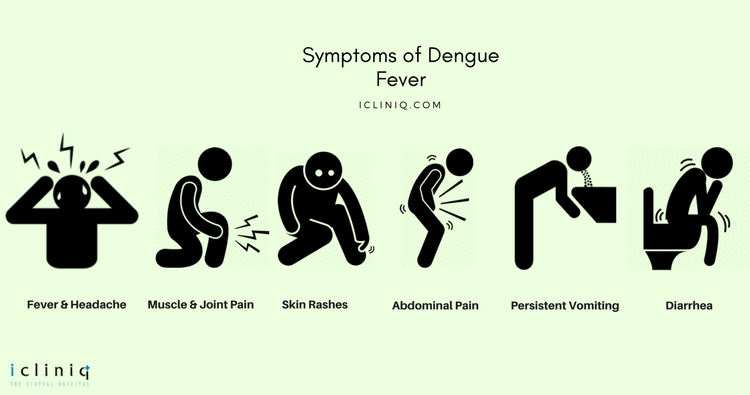
In cases of severe dengue, medical care from physicians and nurses experienced in the presentation and progression of the disease can save lives and reduce mortality rates to less than 1% in most countries.
Dengue vaccine
Sanofi Pasteur’s first dengue vaccine, Dengvaxia® (CYD-TDV), was licensed in December 2015 and has already been registered with regulatory authorities in approximately 20 countries. An additional analysis was released in November 2017 to retrospectively determine the serostatus of individuals at the time they were vaccinated. The analysis showed that a subset of study participants who were presumed to be seronegative at the time of their first vaccination were at an increased risk of more severe dengue and hospitalization as a result of the disease compared with unvaccinated participants. Therefore, the CYD-TDV vaccine is intended for use in people aged nine to 45 years who live in endemic areas and who have had at least one episode of dengue infection.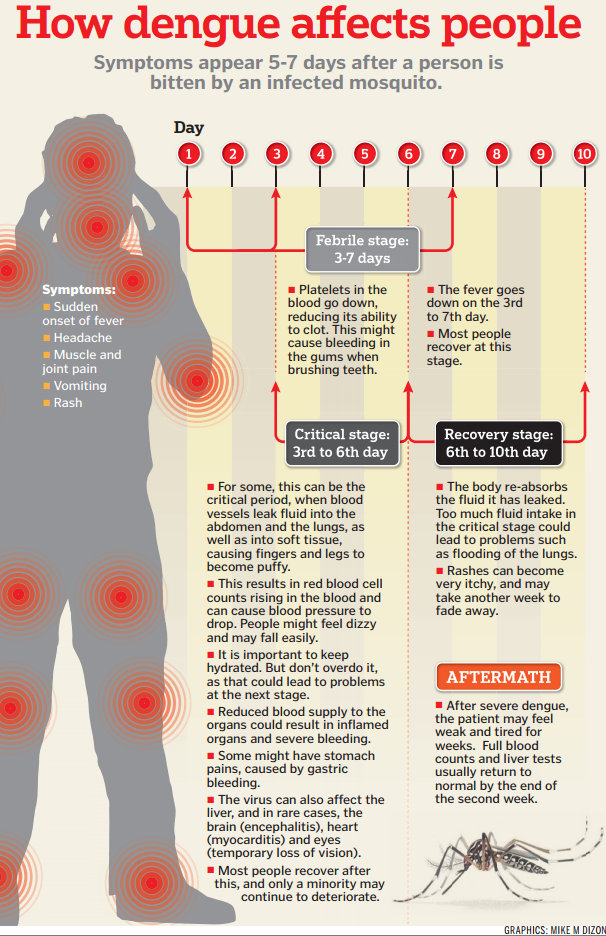 Several other dengue vaccine candidates are currently under study.
Several other dengue vaccine candidates are currently under study.
WHO position paper on CYD-TDV[26]
As noted in the WHO Position Paper on Dengvaxia (September 2018) [26], live attenuated CYD-TDV dengue vaccine has been demonstrated in clinical trials to efficacy and safety in individuals who have previously had a dengue infection (seropositive individuals). The recommended strategy for countries considering vaccination as part of a dengue control program is to conduct pre-vaccination screening. Under this strategy, only individuals with a proven history of dengue infection (based on an antibody test or laboratory documentation of a past history of dengue infection) are eligible to be vaccinated. The decision to implement a pre-vaccination screening strategy should be made after carefully assessing the country situation, including the sensitivity and specificity of available tests, as well as local priorities, the epidemiology of dengue, country-specific dengue hospitalization rates, and the affordability of both CYD-TDV and screening tests.
Vaccination should be considered as part of a comprehensive dengue prevention and control strategy. It does not replace the need to continue to take other disease prevention measures, in particular to conduct well-organized and targeted vector control. People who develop dengue-like symptoms should seek immediate medical attention, whether they have been vaccinated or not.
Risk factors
The risk of developing severe dengue is increased by a history of previous DENV infection.
Urbanization (especially spontaneous) contributes to the transmission of dengue through a range of social and environmental factors, such as population density and mobility, availability of reliable water supplies, water storage practices, etc.
The risk of local spread of dengue also depends on the level of knowledge of the population about dengue and related attitudes and behaviors, as well as the implementation of planned vector control activities in a particular locality.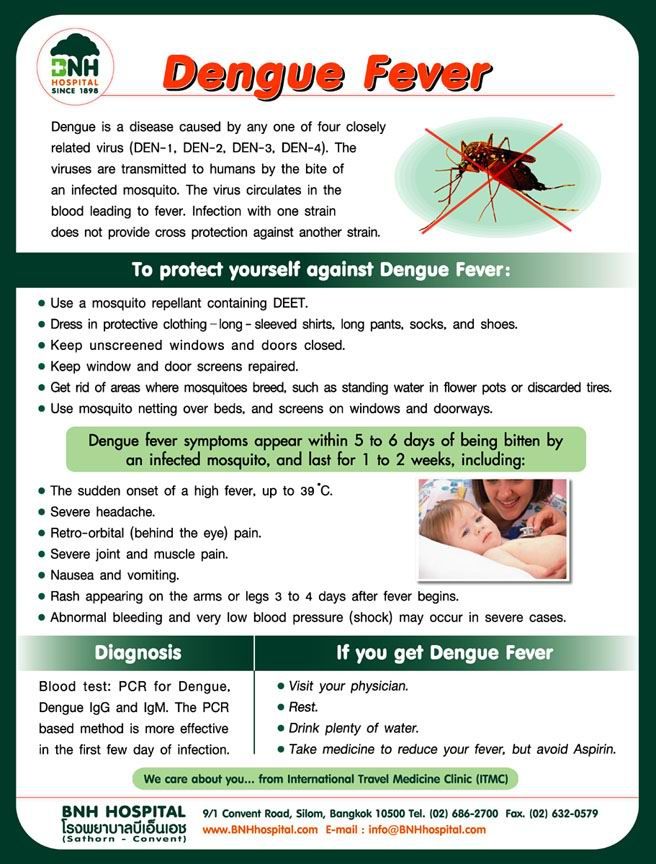
Subsequently, as the climate changes in tropical and subtropical areas, and as vectors may adapt to new environmental and climatic conditions, the scale and geography of the risks associated with the disease may change.
Dengue prevention and control
Patients with established dengue should avoid further mosquito bites during the first week of illness. During this time, the virus can circulate in the blood and the patient can transmit the virus to other uninfected mosquitoes, which in turn can infect other people.
One of the most important risk factors for dengue and other infections is the proximity of mosquito breeding sites to human habitats. Currently, the main way to contain or prevent transmission of the dengue virus is to control mosquito-carrying mosquitoes. This is achieved through the following measures:
prevention of mosquito breeding:
prevention of mosquitoes’ access to egg-laying sites by arrangement and modification of environmental objects;
proper disposal of solid waste and destruction of man-made objects that can retain water and provide habitat for mosquitoes;
storage of water supplies in closed containers indoors and weekly emptying and washing of containers;
treatment of outdoor water storage tanks with suitable insecticides;
personal protection against mosquito bites:
use of personal protective equipment such as window screens, mosquito repellents, coils and evaporators. These measures should be taken during the daytime both inside and outside the home (eg at work/school) as mosquitoes, the main vectors of infection, bite throughout the day;
These measures should be taken during the daytime both inside and outside the home (eg at work/school) as mosquitoes, the main vectors of infection, bite throughout the day;
wearing clothing that covers the skin as much as possible to protect it from mosquito bites;
community outreach:
public awareness of the risks associated with mosquito-borne diseases;
community outreach to increase community involvement in sustained vector control;
active monitoring of mosquitoes and virus:
active monitoring and surveillance of species abundance and composition is necessary to determine the effectiveness of vector control measures;
Prospective monitoring of the prevalence of the virus in mosquito populations based on active screening of indicator collections of mosquitoes should be carried out;
Vector surveillance may be carried out as part of clinical public health surveillance and environmental monitoring.
In addition, many groups of international partners continue to conduct research to find new tools and innovative strategies that will contribute to the global effort to stop dengue transmission.


 Entomological and virological surveillance for dengue virus in churches in Merida, Mexico. Rev Inst Med Trop Sao Paulo. 2019 Feb 14;61:e9. [PMC free article: PMC6376932] [PubMed: 30785563]
Entomological and virological surveillance for dengue virus in churches in Merida, Mexico. Rev Inst Med Trop Sao Paulo. 2019 Feb 14;61:e9. [PMC free article: PMC6376932] [PubMed: 30785563]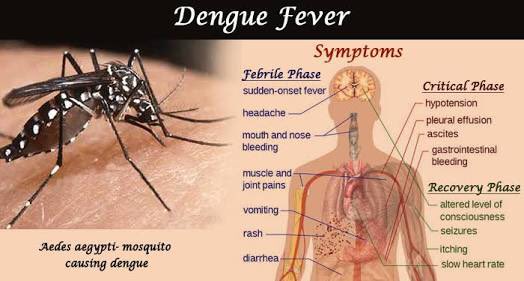
 Dengue virus is an under-recognised causative agent of acute encephalitis syndrome (AES): Results from a four year AES surveillance study of Japanese encephalitis in selected states of India. Int J Infect Dis. 2019 Jul;84S:S19-S24. [PubMed: 30641206]
Dengue virus is an under-recognised causative agent of acute encephalitis syndrome (AES): Results from a four year AES surveillance study of Japanese encephalitis in selected states of India. Int J Infect Dis. 2019 Jul;84S:S19-S24. [PubMed: 30641206] Using clinical practice guidelines to manage dengue: a qualitative study in a Malaysian hospital. BMC Infect Dis. 2019 Jan 11;19(1):45. [PMC free article: PMC6329084] [PubMed: 30634929]
Using clinical practice guidelines to manage dengue: a qualitative study in a Malaysian hospital. BMC Infect Dis. 2019 Jan 11;19(1):45. [PMC free article: PMC6329084] [PubMed: 30634929] [PMC free article: PMC7179939] [PubMed: 32282862]
[PMC free article: PMC7179939] [PubMed: 32282862] PLoS Med. 2019 Jan;16(1):e1002726. [PMC free article: PMC6342296] [PubMed: 30668565]
PLoS Med. 2019 Jan;16(1):e1002726. [PMC free article: PMC6342296] [PubMed: 30668565]